Eliza Knight's Blog, page 65
November 8, 2011
March's Madness by Emery Lee
 Today I'd like to welcome guest author, Emery Lee back to History Undressed. She previously visited us in April 2010 with the release of her debut novel,
The Highest Stakes
. She is back with us now to talk about March's Madness and her new release,
Fortune's Son
. Leave a comment for a chance to win a copy of Ms. Lee's novel,
Fortune's Son.
(1 winner, US and Canada only)
Today I'd like to welcome guest author, Emery Lee back to History Undressed. She previously visited us in April 2010 with the release of her debut novel,
The Highest Stakes
. She is back with us now to talk about March's Madness and her new release,
Fortune's Son
. Leave a comment for a chance to win a copy of Ms. Lee's novel,
Fortune's Son.
(1 winner, US and Canada only)MARCH'S MADNESS byEmery Lee
To those who have myread my novels to date, my love (readobsession) with the Georgian era is clearly evident. For those of you whohave not, I invite you to open the pages and immerse yourself in a fascinatingparadox that is nowhere better represented than in the lives of Georgianaristocrats - many of whom adopted an outward veneer to hide the sin within.
In my first novel,THE HIGHEST STAKES, I delved deeply into the obsessive world of horseracing andarranged marriages, where nothing was sacred and an individual's happiness(particularly if one happened to be female) was easily laid aside to advance afamily's political or social agenda.
In FORTUNE'S SON I furtherexplore the gaming world and it often served as more than a merediversion, but as a last resort for thosewith reduced circumstances whose social position did not allow any manner ofgaining a more honest income. Compelledto wager, many faced financial devastation and social ruin, while occasionally(and incomprehensibly), Fortune seemed to smile on particular individuals forno particular reason. One such colorful example(whom I delighted in bringing to life as a secondary character in FORTUNE'SSON) was
Although many young, aristocrats lacking more worthypursuits, squandered their days at race tracks, cockpits, or over the greenbaize tables, Lord March's exploits and love of a wager are legendary even forthe gaming Georgians. His most infamouswager has come to be known over the ages as Lord March's "race against time"and plays a significant role in FORTUNE'S SON.
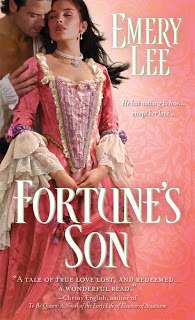 (Excerpt from FORTUNE'S SON chapter 39)
(Excerpt from FORTUNE'S SON chapter 39) March signaled a lackey for a newpack of cards to replace those he'd swept off the table to join the moundsscattered about the floor. "One can dovery well on credit," said March. "By way of example, I have no fewer thanthree carriage makers, and four cartwrights, currently engineering a contraptionfor my upcoming wager with Taaffe and Sprowle."
"Are you still about that madness,March?" George Selwyn asked.
"What madness is this?" Philip inquired,laying down fifty guineas, and hoping his careless manner belied the near-emptinessof his pockets. March and Selwyn matched his stakes, and he absently dealt thefirst two cards, face-up to his immediate left.
"A bloody chariot race," said George."As a fellow turf man, you'll doubtless find the fellow's scheme mostdiverting."
"I daresay Hastings has had his fill of racingwagers." Lord March's jibe at Philip's recent loss hit home.
"Not at all, my lord," Philip repliedcoolly. "When one plays, one must expect eventually to pay."
Lord March regarded Philip speculatively."I never begrudge a man who wins from me fairly."
"Then I remind you 'tis now pastnoon, and our friend Hastings is alive, hale, and in present company," saidGeorge, referring to their earlier wager.
Lord March carelessly unfolded afifty-pound bank note from a wad of bills in his pocket, and handed it toGeorge, whilst continuing his narrative. "The chariot wager was made some six-monthpast when Count Taaffe, that damnable upstart Irishman, boasted of having thefastest chaise and four in the country. When challenged to prove the claim, he assertedhe'd clocked them at twelve miles in an hour. 'Twelve miles?' says I. 'Why I'lllay you a thousand guineas, I can produce a chaise and team half again as fast.'Believing me out of my head, Taaffe readily accepted my wage."
Philip replied with a chuckle, "You are outof your head, March! Eighteen miles in an hour? An impossible feat. The fastestcoach pulled by a team of six doesn't exceed ten miles per hour."
March broke into a slow, sly smile. "Acarriage is quite an ambiguous thing is it not?" March said. "Since the termsof the wager did not specify a body be fitted to the carriage, our passengerwill be slung on leather straps between the two hind wheels. While united theback carriage to the fore in the usual manner, to reduce weight, we used cordsand springs, and the pole and bars are of thin wood reinforced with supportingwire. As to the harness, an optimal lightness was achieved by constructing thetraces from silk, and the breechings, of whalebone."
"Silk and whalebone? Do you wish toharness your horses or to corset them?" Philip chuckled. "And you think todrive this deathtrap at eighteen miles per hour?"
"A ridiculous notion, Hastings! Youthink I'd take such a risk when I employ any number of competent grooms todrive the contraption?"
"Dare I ask how many have perished inthe trials?"
"Why none have suffered worse than afew broken limbs," March replied indignantly, but then confessed that he hadlost half a dozen horses, explaining, "They were only second-rate runners. Forthe true trials I require nothing less than four plate winners."
Philip was astounded. "You would riskfour plate-winning horses for a thousand guineas? Mayhap your mind isdisordered after all."
Lord March answered heatedly. "It'sthe principle of the thing, Hastings! Besides, the odds are posted at four toone against me, which means I stand to gain a huge sum in secondary wagers, butthe money has become inconsequential. Hell, I'm seven hundred pounds invested alreadyand as like to treble that amount before all is said and done. But I'll see itthrough, by God."
"That would answer," Philip replied. "Myhat is off to you, March. You are truly one calculating devil. But if you loseany more horses in the training runs, how do you propose to win?"
"I only need four to race, Hastings.I propose to retain a stable of six plate winners as a contingency. I'msaving the best of the lot for last, and won't set the date until I deem theequipage fit, and the horses fitter." March's lips curved up at the corners. "Afterall, I race only to win." - ( End of excerpt)
LORD MARCH'S FAMOUS RACINGCHAISE
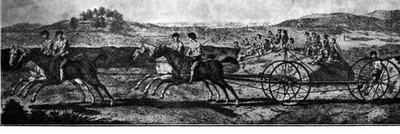
True to formuntil the very end, gambling, horses, and women continued to be Old Q's life passions until his death at the ripe oldage of eighty five.
*~*~*~*
Emery Lee is a trueromantic and self-professed "GeorgianJunkie." She is also the moderator forGoodreads Romantic Historical Fiction Lovers.
http://authoremerylee.com
http://georgianjunkie.wordpress.com
Published on November 08, 2011 03:00
November 7, 2011
Guest Blogger Christina Courtenay on Men in Kilts
Today I'd like to welcome Christina Courtenay to History Undressed! She's written an article today that is near and dear to many hearts :) -- Men in Kilts!
Men in Kilts by Christina Courtenay
 What is it about men in kilts that fascinates romance readers so? I'm not sure, but I have to confess I'm one of the fans of this genre. I've loved romance stories set in Scotland since I first discovered there was such a thing, and whether they have a bare-chested hero in a kilt on the cover or not, I can't get enough of them. I was therefore really keen to write a novel set in the Highlands myself. Imagine my chagrin then, when I found that my hero couldn't wear a kilt at all!
What is it about men in kilts that fascinates romance readers so? I'm not sure, but I have to confess I'm one of the fans of this genre. I've loved romance stories set in Scotland since I first discovered there was such a thing, and whether they have a bare-chested hero in a kilt on the cover or not, I can't get enough of them. I was therefore really keen to write a novel set in the Highlands myself. Imagine my chagrin then, when I found that my hero couldn't wear a kilt at all!
My story, Highland Storms, is set in 1754, eight years after the battle of Culloden, which as we all know, the Jacobites lost. As a consequence of the failed rebellion, the victorious English tried to virtually eradicate all Highland culture and this included their clothing. The New Disarming Act of 12th August 1746 banned them from wearing any type of Highland dress (as well as possessing weapons) and this meant no tartan/plaids of any kind and no kilts. This didn't stop me doing some research into Highland dress, however, and I was surprised to find that what we now refer to as kilts are very different to what most of the men wore before the Jacobite uprising. I thought I'd share some of my findings with you.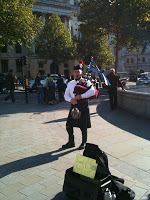 The kilts in those days were not the tiny versions we have now, although something similar did exist – they were called feileadh beag (little wrap or Philabeg in English). However, most Highlanders wore the old type of kilt, usually called a "great wrap", "tartan wrap" or"belted plaid" back then. They were a much larger and rougher version and wouldn't have looked as neat and tidy as the ready-made ones available to us.
The kilts in those days were not the tiny versions we have now, although something similar did exist – they were called feileadh beag (little wrap or Philabeg in English). However, most Highlanders wore the old type of kilt, usually called a "great wrap", "tartan wrap" or"belted plaid" back then. They were a much larger and rougher version and wouldn't have looked as neat and tidy as the ready-made ones available to us.
A plaid by itself could be just a length of woollen fabric worn over the body like a mantle, but a "belted plaid" was different. It was made of a piece of material from about three to five yards long and two loom breadths wide, which equals around 50 inches. This was set in folds and fastened around the waist to make a sort of skirt that reached half way down the thigh. The rest was brought over the shoulders and fastened at the front, below the neck, usually with a bodkin, pin or sharp piece of stick. It could also be brought up over the head to protect the wearer during bad weather. It was a wonderful outfit for any soldier (especially the guerilla type, sleeping rough in the mountains) or anyone else travelling through the Highlands, as it served as bedding by night and clothes in the day time. Made of wool, it must have smelled pretty bad (as did a lot of things in those days!) – the Englishman Edmund Burt, who lived in the Highlands for a while during the early 18th century, reported to a friend that "… one thing I should have told you [which] was intolerable … the number of Highlanders that attended at table, whose feet and linen, or woolen, I don't know which, were more than a match for the odour of the dishes." Of course, if you make wool wet, it smells more than usual (anyone who has a dog will know what I mean). However, wetting it also has a benefit in that the moisture makes the wool thicker and thereby keeps you warmer. In contact with body heat, it makes a sort of steam, which meant Highlanders could even sleep in snow if they had to and still stay fairly warm. And Highlanders, from what I understand, were used to being wet – it didn't bother them.
Made of wool, it must have smelled pretty bad (as did a lot of things in those days!) – the Englishman Edmund Burt, who lived in the Highlands for a while during the early 18th century, reported to a friend that "… one thing I should have told you [which] was intolerable … the number of Highlanders that attended at table, whose feet and linen, or woolen, I don't know which, were more than a match for the odour of the dishes." Of course, if you make wool wet, it smells more than usual (anyone who has a dog will know what I mean). However, wetting it also has a benefit in that the moisture makes the wool thicker and thereby keeps you warmer. In contact with body heat, it makes a sort of steam, which meant Highlanders could even sleep in snow if they had to and still stay fairly warm. And Highlanders, from what I understand, were used to being wet – it didn't bother them.
These plaids or tartans could be of many colors, but for warfare the Highlanders seem to have favored plainer ones, mostly brown. That way, they were camouflaged when they lay down in the heather and this apparently annoyed the English no end! In fact, the belted plaid was the garment the English objected to the most because they said it was '… calculated for the encouragement of an idle life in lying about upon the heather in the daytime instead of following some lawful employment … [it] serves to cover them in the night when they lie in wait among the mountains to commit robberies, composed of such colours as ... nearly resemble the heath on which they lie so you don't see them until you're very close, [and it] renders them ready at a moment's notice to join in any rebellion'. Well, it seems very sensible to me so why wouldn't they have worn it?
 Natural dyes, like those made from nettles, lichen, leaves, heather and roots etc, were used for the wool. Only rich people imported dye like red or blue and it's amazing the range of colors you can get by just using what nature provides. One of my aunts has experimented with colors made of different types of moss, for example, and although they are muted, they're still very pretty.
Natural dyes, like those made from nettles, lichen, leaves, heather and roots etc, were used for the wool. Only rich people imported dye like red or blue and it's amazing the range of colors you can get by just using what nature provides. One of my aunts has experimented with colors made of different types of moss, for example, and although they are muted, they're still very pretty.
The belted plaid was most convenient for those travelling in the mountains, as wearing breeches would not have given them the same freedom of movement. And apparently they really didn't wear anything underneath their belted plaid except a shirt - Mr Burt also reports to his friend that an Englishwoman he knew had been offended by the sight before her when a Highland guide climbed a hill ahead of her!
The "little wrap" evolved when the men needed a less cumbersome garment. It consisted of only one width of material, pleated and belted round the waist, without the extra bit that was flung over the shoulders. This was preferable for certain occupations where the large belted plaid would just have been in the way.
Women didn't wear belted plaids, of course, but they did have a very similar garment – the arisaid. This was more like a blanket or mantle used to keep them warm and dry in cold or wet weather. They put it on by pleating about two thirds of it round the waist and fixing it in place with a belt, leaving a gap at the front. The left-over piece, you pulled up behind you and round the shoulders, fastening it with a crude pin. Just like the belted plaid, it could be pulled up over the head. The arisaidswere often chequered before the Jacobite uprising, but afterwards, when they were still allowed, they were mostly plain, sometimes with a stripe at the edge. They sound very useful, especially in a place like the Highlands which is so often wet and cold!
Many thanks for having me as your guest, Eliza!
(Quote from "Burt's Letters from the North of Scotland", ISBN 978-1-874744-90-0)
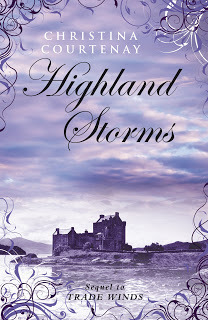 Highland Storms
Who can you trust? Betrayed by his brother and his childhood love, Brice Kinross needs a fresh start. So he welcomes the opportunity to leave Sweden for the Scottish Highlands to take over the family estate.
Highland Storms
Who can you trust? Betrayed by his brother and his childhood love, Brice Kinross needs a fresh start. So he welcomes the opportunity to leave Sweden for the Scottish Highlands to take over the family estate.
But there's trouble afoot at Rosyth in 1754 and Brice finds himself unwelcome. The estate is in ruin and money is disappearing. He discovers an ally in Marsaili Buchanan, the beautiful redheaded housekeeper, but can he trust her?
Marsaili is determined to build a good life. She works hard at being housekeeper and harder still at avoiding men who want to take advantage of her. But she's irresistibly drawn to the new clan chief, even though he's made it plain he doesn't want to be shackled to anyone. And the young laird has more than romance on his mind. His investigations are stirring up an enemy. Someone who will stop at nothing to get what he wants – including Marsaili – even if that means destroying Brice's life forever … Highland Storms, ISBN: 978-1-906931-71-1, published by Choc Lit 1st November 2011, available now from Amazon
Link to excerpt
Christina Courtenay lives in London, UK, and is married with two children. Although born in England she has a Swedish mother and was brought up in Sweden. In her teens, the family moved to Japan where she had the opportunity to travel extensively in the Far East.Christina is Vice Chairman of the UK's Romantic Novelists' Association. She won the Elizabeth Goudge Trophy for a historical short story in 2001 and the Katie Fforde Bursary for a promising new writer in 2006. Highland Storms is Christina's third Choc Lit novel. Her debut, Trade Winds and prequel to Highland Storms, was short listed for the Romantic Novelists' Association's Pure Passion Award of Best Historical Fiction 2011. Her second novel, The Scarlet Kimono won Best Historical Fiction price for the Big Red Read and was shortlisted for the inaugural Festival of Romance Readers Award for Best Historical Read 2011.As well as her novels, Christina has published four Regency novellas.Visit: www.christinacourtenay.com Follow Christina on Facebook and Twitter www.twitter.com/PiaCCourtenay
Men in Kilts by Christina Courtenay
 What is it about men in kilts that fascinates romance readers so? I'm not sure, but I have to confess I'm one of the fans of this genre. I've loved romance stories set in Scotland since I first discovered there was such a thing, and whether they have a bare-chested hero in a kilt on the cover or not, I can't get enough of them. I was therefore really keen to write a novel set in the Highlands myself. Imagine my chagrin then, when I found that my hero couldn't wear a kilt at all!
What is it about men in kilts that fascinates romance readers so? I'm not sure, but I have to confess I'm one of the fans of this genre. I've loved romance stories set in Scotland since I first discovered there was such a thing, and whether they have a bare-chested hero in a kilt on the cover or not, I can't get enough of them. I was therefore really keen to write a novel set in the Highlands myself. Imagine my chagrin then, when I found that my hero couldn't wear a kilt at all!My story, Highland Storms, is set in 1754, eight years after the battle of Culloden, which as we all know, the Jacobites lost. As a consequence of the failed rebellion, the victorious English tried to virtually eradicate all Highland culture and this included their clothing. The New Disarming Act of 12th August 1746 banned them from wearing any type of Highland dress (as well as possessing weapons) and this meant no tartan/plaids of any kind and no kilts. This didn't stop me doing some research into Highland dress, however, and I was surprised to find that what we now refer to as kilts are very different to what most of the men wore before the Jacobite uprising. I thought I'd share some of my findings with you.
 The kilts in those days were not the tiny versions we have now, although something similar did exist – they were called feileadh beag (little wrap or Philabeg in English). However, most Highlanders wore the old type of kilt, usually called a "great wrap", "tartan wrap" or"belted plaid" back then. They were a much larger and rougher version and wouldn't have looked as neat and tidy as the ready-made ones available to us.
The kilts in those days were not the tiny versions we have now, although something similar did exist – they were called feileadh beag (little wrap or Philabeg in English). However, most Highlanders wore the old type of kilt, usually called a "great wrap", "tartan wrap" or"belted plaid" back then. They were a much larger and rougher version and wouldn't have looked as neat and tidy as the ready-made ones available to us. A plaid by itself could be just a length of woollen fabric worn over the body like a mantle, but a "belted plaid" was different. It was made of a piece of material from about three to five yards long and two loom breadths wide, which equals around 50 inches. This was set in folds and fastened around the waist to make a sort of skirt that reached half way down the thigh. The rest was brought over the shoulders and fastened at the front, below the neck, usually with a bodkin, pin or sharp piece of stick. It could also be brought up over the head to protect the wearer during bad weather. It was a wonderful outfit for any soldier (especially the guerilla type, sleeping rough in the mountains) or anyone else travelling through the Highlands, as it served as bedding by night and clothes in the day time.
 Made of wool, it must have smelled pretty bad (as did a lot of things in those days!) – the Englishman Edmund Burt, who lived in the Highlands for a while during the early 18th century, reported to a friend that "… one thing I should have told you [which] was intolerable … the number of Highlanders that attended at table, whose feet and linen, or woolen, I don't know which, were more than a match for the odour of the dishes." Of course, if you make wool wet, it smells more than usual (anyone who has a dog will know what I mean). However, wetting it also has a benefit in that the moisture makes the wool thicker and thereby keeps you warmer. In contact with body heat, it makes a sort of steam, which meant Highlanders could even sleep in snow if they had to and still stay fairly warm. And Highlanders, from what I understand, were used to being wet – it didn't bother them.
Made of wool, it must have smelled pretty bad (as did a lot of things in those days!) – the Englishman Edmund Burt, who lived in the Highlands for a while during the early 18th century, reported to a friend that "… one thing I should have told you [which] was intolerable … the number of Highlanders that attended at table, whose feet and linen, or woolen, I don't know which, were more than a match for the odour of the dishes." Of course, if you make wool wet, it smells more than usual (anyone who has a dog will know what I mean). However, wetting it also has a benefit in that the moisture makes the wool thicker and thereby keeps you warmer. In contact with body heat, it makes a sort of steam, which meant Highlanders could even sleep in snow if they had to and still stay fairly warm. And Highlanders, from what I understand, were used to being wet – it didn't bother them.These plaids or tartans could be of many colors, but for warfare the Highlanders seem to have favored plainer ones, mostly brown. That way, they were camouflaged when they lay down in the heather and this apparently annoyed the English no end! In fact, the belted plaid was the garment the English objected to the most because they said it was '… calculated for the encouragement of an idle life in lying about upon the heather in the daytime instead of following some lawful employment … [it] serves to cover them in the night when they lie in wait among the mountains to commit robberies, composed of such colours as ... nearly resemble the heath on which they lie so you don't see them until you're very close, [and it] renders them ready at a moment's notice to join in any rebellion'. Well, it seems very sensible to me so why wouldn't they have worn it?
 Natural dyes, like those made from nettles, lichen, leaves, heather and roots etc, were used for the wool. Only rich people imported dye like red or blue and it's amazing the range of colors you can get by just using what nature provides. One of my aunts has experimented with colors made of different types of moss, for example, and although they are muted, they're still very pretty.
Natural dyes, like those made from nettles, lichen, leaves, heather and roots etc, were used for the wool. Only rich people imported dye like red or blue and it's amazing the range of colors you can get by just using what nature provides. One of my aunts has experimented with colors made of different types of moss, for example, and although they are muted, they're still very pretty. The belted plaid was most convenient for those travelling in the mountains, as wearing breeches would not have given them the same freedom of movement. And apparently they really didn't wear anything underneath their belted plaid except a shirt - Mr Burt also reports to his friend that an Englishwoman he knew had been offended by the sight before her when a Highland guide climbed a hill ahead of her!
The "little wrap" evolved when the men needed a less cumbersome garment. It consisted of only one width of material, pleated and belted round the waist, without the extra bit that was flung over the shoulders. This was preferable for certain occupations where the large belted plaid would just have been in the way.
Women didn't wear belted plaids, of course, but they did have a very similar garment – the arisaid. This was more like a blanket or mantle used to keep them warm and dry in cold or wet weather. They put it on by pleating about two thirds of it round the waist and fixing it in place with a belt, leaving a gap at the front. The left-over piece, you pulled up behind you and round the shoulders, fastening it with a crude pin. Just like the belted plaid, it could be pulled up over the head. The arisaidswere often chequered before the Jacobite uprising, but afterwards, when they were still allowed, they were mostly plain, sometimes with a stripe at the edge. They sound very useful, especially in a place like the Highlands which is so often wet and cold!
Many thanks for having me as your guest, Eliza!
(Quote from "Burt's Letters from the North of Scotland", ISBN 978-1-874744-90-0)
 Highland Storms
Who can you trust? Betrayed by his brother and his childhood love, Brice Kinross needs a fresh start. So he welcomes the opportunity to leave Sweden for the Scottish Highlands to take over the family estate.
Highland Storms
Who can you trust? Betrayed by his brother and his childhood love, Brice Kinross needs a fresh start. So he welcomes the opportunity to leave Sweden for the Scottish Highlands to take over the family estate. But there's trouble afoot at Rosyth in 1754 and Brice finds himself unwelcome. The estate is in ruin and money is disappearing. He discovers an ally in Marsaili Buchanan, the beautiful redheaded housekeeper, but can he trust her?
Marsaili is determined to build a good life. She works hard at being housekeeper and harder still at avoiding men who want to take advantage of her. But she's irresistibly drawn to the new clan chief, even though he's made it plain he doesn't want to be shackled to anyone. And the young laird has more than romance on his mind. His investigations are stirring up an enemy. Someone who will stop at nothing to get what he wants – including Marsaili – even if that means destroying Brice's life forever … Highland Storms, ISBN: 978-1-906931-71-1, published by Choc Lit 1st November 2011, available now from Amazon
Link to excerpt
Christina Courtenay lives in London, UK, and is married with two children. Although born in England she has a Swedish mother and was brought up in Sweden. In her teens, the family moved to Japan where she had the opportunity to travel extensively in the Far East.Christina is Vice Chairman of the UK's Romantic Novelists' Association. She won the Elizabeth Goudge Trophy for a historical short story in 2001 and the Katie Fforde Bursary for a promising new writer in 2006. Highland Storms is Christina's third Choc Lit novel. Her debut, Trade Winds and prequel to Highland Storms, was short listed for the Romantic Novelists' Association's Pure Passion Award of Best Historical Fiction 2011. Her second novel, The Scarlet Kimono won Best Historical Fiction price for the Big Red Read and was shortlisted for the inaugural Festival of Romance Readers Award for Best Historical Read 2011.As well as her novels, Christina has published four Regency novellas.Visit: www.christinacourtenay.com Follow Christina on Facebook and Twitter www.twitter.com/PiaCCourtenay
Published on November 07, 2011 05:34
November 4, 2011
SCOTLAND'S EARTHQUAKE HISTORY by Nancy Lee Badger
Welcome back to History Undressed, guest author, Nancy Lee Badger! Nancy has tantalized us so many times in the past with articles on dragons, ales and Scots, and she's back again to entertain us some more with her article today!
SCOTLAND'S EARTHQUAKE HISTORY by Nancy Lee Badger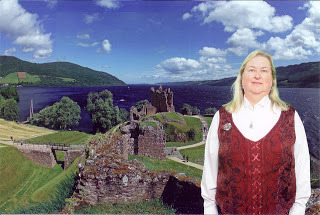 Earthquakes across the world havebeen in the news lately. From the recent devastation in Turkey, to theunderwater quake and its accompanying tsunami that caused thousands of deathsin Japan, when the earth moves, we listen. Even here in North Carolina, I feltthe house shake when an earthquake hit near Washington, DC just this pastAugust. What about another location where we rarely hear about experiencingtremblers: Scotland. Yes, Scotland has earthquakes but unless you live there,you probably do not hear talk of them on the news. Why, then, are earthquakesfound in my latest romantic fantasy, DRAGON IN THE MIST?
Earthquakes across the world havebeen in the news lately. From the recent devastation in Turkey, to theunderwater quake and its accompanying tsunami that caused thousands of deathsin Japan, when the earth moves, we listen. Even here in North Carolina, I feltthe house shake when an earthquake hit near Washington, DC just this pastAugust. What about another location where we rarely hear about experiencingtremblers: Scotland. Yes, Scotland has earthquakes but unless you live there,you probably do not hear talk of them on the news. Why, then, are earthquakesfound in my latest romantic fantasy, DRAGON IN THE MIST?
When I write a story—any story—Iresearch the location. To me, location is also a character, and as important asmy hero or heroine. Where a story takes place is quintessential to my plot, so myreaders can feel they are there, in the story. For DRAGON IN THE MIST, looselybased on the Loch Ness Monster, I needed a secondary reason for my hero, theAmerican scientist Rory Hawthorn, to travel to a small town on the banks ofLoch Ness. When my research gave me a glimmer of an idea, I quickly made mypresent-day American hero a geologist. Covertly searching for the root of afamily curse, he told his family he was traveling Scotland to research itsearthquake history.
Does Scotland experience quakes? Iwas as surprised as you to find statistics reporting several large earthquakesevery century. One of Scotland's largest quakes occurred back in 1816, so I setthe beginning of my book in the past and used my heroine, Nessía—in her LochNess Monster from—causing the quakes by slamming her head into the loch'sunderwater sheer sides. 1816 fit the timeline I wanted to show in the book'sfirst chapter, after which the story continues in present day.
So, what exactly causes anearthquake? Let me start with a littleinformation about the area that includes Loch Ness, where my book takes place. LochNess, south of Inverness, is 23 miles long and about 1 mile wide. Thoughnarrow, it averages a whopping 600 feet in depth, making the loch dark, cold,and eerie. The loch is shaped like a long, deep trench and follows the line ofthe Great Glen Fault. The area was originally beneath a huge glacier.
Yes, Scotland's Loch Ness has afault similar to the large, active San Andreas fault in California. Luckily forthe residents of the Highlands of Scotland, the Great Glen Fault is much lessactive, but it has seen activity for over 400 million years. Scientists havediscovered Foyers and Strontian granite from the same intrusion now 66 milesapart. Let's just agree the land is shifting and moving, slow but sure. Guess where the shatter belt ofrock produced by the fault movement mostly lies? Under Loch Ness! Visitors to Urquhart castle overlooking theloch might not have noticed the shattered rock evident in road cuttings. Heatand stress evidence tells local geologists that movement occurred over andover.
Let's get back to the earthquakefrequency. The Loch Ness area, where DRAGON IN THE MIST is set, averages 3earthquakes each century that measure at least a 4.0 on the Richter Scale, themethod used to describe an earthquakes ferocity. In comparison to the strengthsand amounts of quakes that hit the state of California, Scotland's rumbles arerare. Could I use such a history in my story? You bet! I twisted this historyto claim that my heroine, Nessía of the Lake, caused the earthquakes while inher serpentine, underwater wingless dragon form.
Why not? In fiction, even in aromance where I have set my story and its characters in our same world, I havethe freedom to change the rules a little.
Whatabout other areas of Scotland? I found an article from August 2011 about recentScottish earthquakes. Apparently, five earthquakes were felt in the westHighlands followed by the recording of three lesser quakes. The BritishGeological Survey (BGS) recorded the first and largest, of 2.9 magnitude, atLochailort, with smaller quakes recorded between 11:13 and 18:24. The weekend'sevents occurred in the Lochaber Geopark. As reported by the BBC.com/UK, Parkdirector Noel Williams said: "Most earthquakes in Lochaber occur asunweighting of the earth after the melting of the ice formed during the lastglacial period some 12,000 years ago. The land effectively 'bounces back upagain' a process Earth scientists term isostatic rebound."The BGS saidearthquakes were a common event in the west Highlands but added that to havefive on the same day was "slightly unusual".
As Imentioned earlier, earthquakes measuring over 4.0 are rare, but these smallerquakes still made the news because they were noticeable in quiet places, duringa quiet time. A previous quake was reported in Knoydart on 30 July. Earthquake 'swarms'have also been recorded in Dumfrieshire and in parts of Perthshire. I did findanother story reporting a 3.5 quake rocked the western shores of Scotland inJanuary 2011, which included the southern end of Loch Ness. People in Inverness,at the northern end of Loch Ness, reported feeling it over 120 km away. It issafe to say Loch Ness rippled!
The islands off the western coastof Scotland were formed by volcanoes, and volcanoes breed quakes. I set my bookDRAGON'S CURSE on the island of Staffa due to its odd hexagonal rock formationsand huge caves. Scotland has no dormant or active volcanoes, but plenty of'plugs'. A plug is the remainder of the neck of a Volcano. Devil's tower inWyoming is a good example of an ancient volcano neck. In Scotland, ancientdwellings have been discovered on the summit of North Berwick Law, the roundedvolcanic remains which sit 613 feet above sea level. It even has a 'tail'caused by a retreating glacier. A famous tourist attraction sits on another plug:Edinburgh Castle.
Earthquakes might be considered aminor aberration in Scotland…unless you live there! What my research taught me,is that you never know what you might find when you delve into the historybehind the topography of a book's location. Use the facts to your advantagewhen writing to give your readers a better perspective while they fall in lovewith your characters. And to my readers, I hope you fall in love with Nessia,Rory, and Scotland when you read DRAGON'S CURSE and my latest release, DRAGONIN THE MIST.
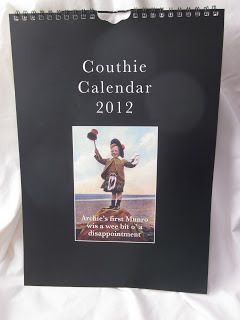 Nancy has a prize for one very special commenter! Leave a comment and be eligible for a lovely 2012 Scottish Calendar full of lovely photos and funny comments! Sure to put a smile on the face of any laddie or lassie.
Nancy has a prize for one very special commenter! Leave a comment and be eligible for a lovely 2012 Scottish Calendar full of lovely photos and funny comments! Sure to put a smile on the face of any laddie or lassie.
BOOKBLURB
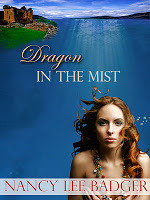 Life without love is not worthliving.Nessía of theLoch has lived beneath the murky water of Loch Ness since ancient times. Thepain of loneliness manifests in anger so strong, the entire valley shakes withearthquakes. In 1816, a Faerie queen pleads for her to cease the tremors andrewards Nessía with a human form. To stay human, she must find love. When theman she believes she loves casts her aside, Nessía responds to the betrayal bycursing the men of the MacDonald clan with the inability to keep a woman'slove. Only an act of true selflessness will break the curse.
Life without love is not worthliving.Nessía of theLoch has lived beneath the murky water of Loch Ness since ancient times. Thepain of loneliness manifests in anger so strong, the entire valley shakes withearthquakes. In 1816, a Faerie queen pleads for her to cease the tremors andrewards Nessía with a human form. To stay human, she must find love. When theman she believes she loves casts her aside, Nessía responds to the betrayal bycursing the men of the MacDonald clan with the inability to keep a woman'slove. Only an act of true selflessness will break the curse.
After centuriespass, Nessía again searches for love. When Rory Hawthorn, an Americanscientist, arrives under the pretext of researching the earthquakes but inreality to research his MacDonald heritage and the curse, she believes she hasfound the perfect mate.
Amid stolenkisses, another earthquake, a steamy night of passion, and a broken heart,Nessía returns to the murky depths of the loch. When Rory dives in to followher, he meets the green, scaly Loch Ness Monster. Assuming Nessía is in danger,he is intent on killing the monster and saving the woman he loves.
EXCERPT
"Whydid he call you Nessie? You obviously don't like it. What's your real name?"the stranger asked while his gaze bore into her chest.
Let him feasthis eyes.
Hesipped his ale, all cool and calm, as he waited for an answer. She pulled backboth shoulders. Waiting until he glanced up, she turned away to ring up adeparting customer's bill, then added the excess to her apron pocket.
Ha! Monty gaveme a 'tip' then left me for his wife.
"Ido not share familiarities with strangers, sir." She preferred to tug thedress's lace edging up, but held back. The trim chafed her low neckline andupper arms, but Mac insisted his servers dress in period costume.
"Forthe tourists, lass," Mac explained the day she walked in and asked for a job.She did not mind the long dress and doeskin shoes, per se. The whole idea ofclothing was bothersome. She enjoyed swimming to the dark depths of the lochclad only in deep green scales.
Evennow, she yearned to swim naked.
"Well,now. I can fix that."
Ittook Nessía a few heartbeats to understand his comeback. Did he refer to herclothing, or to swimming naked? Only oneway to find out. "Fix what, sir?"
"I'llintroduce myself, and then you tell me your name. 'Easy as pie, and polite asrain', my father always said."
Nessíafroze. No, her response caught in her throat and her blood thickened into ice.Fingering the coins in her apron, she willed her talons to stay retracted whileher left foot tapped the plank floor. The stranger's sultry voice was notfamiliar, but the words rang true, because Monty had spoken those, centuriesago.
Nessíastepped closer to the bar. A million questions popped into her head, but shestayed silent. Let him speak first andprove he has no affiliation to that damnable clan.
"Igo by Rory Hawthorn. Though I'm American, I've traced my ancestors to thistown. I plan to be here for quite some time exploring. Learning. Studying theunusual earthquake history of the area."
Earthquakes?What would he say if he knew I caused those tremors?
RoryHawthorn, so called, moved closer. He leaned on the bar, and whispered as ifthe next words were for her ears only.
"AndI very much want to know you better."
AUTHOR BIO
Nancy loves chocolate-chip shortbread,wool plaids wrapped around the trim waist of a Scottish Highlander, the clangof dirks and broadswords, and the sound of bagpipes in the air. Nancy lives thedream. After growing up in Huntington, New York, and raising two handsome sonsin New Hampshire, Nancy moved to North Carolina where she writes full-time. Sheand her family continue to volunteer at the New Hampshire Highland Games eachfall. Nancy is a member of RWA, Heart of Carolina Romance Writers, Sisters InCrime, FF&P Romance Writers, and the Celtic Heart Romance Writers.
Check out her website www.nancyleebadger.com and her blog www.RescuingRomance.nancyleebadger.com.
Follow her on Twitter @NLBadger
and on Facebook http://on.fb.me/scmtx5
Title: DRAGON IN THE MISTAuthor: Nancy Lee Badger
Genre: Romantic Fantasy
Length: 17,000 words
Amazon: http://amzn.to/nNpfNV
Barnes & Noble: http://bit.ly/pzEYYh
Smashwords: http://bit.ly/oKGRDY

SCOTLAND'S EARTHQUAKE HISTORY by Nancy Lee Badger
 Earthquakes across the world havebeen in the news lately. From the recent devastation in Turkey, to theunderwater quake and its accompanying tsunami that caused thousands of deathsin Japan, when the earth moves, we listen. Even here in North Carolina, I feltthe house shake when an earthquake hit near Washington, DC just this pastAugust. What about another location where we rarely hear about experiencingtremblers: Scotland. Yes, Scotland has earthquakes but unless you live there,you probably do not hear talk of them on the news. Why, then, are earthquakesfound in my latest romantic fantasy, DRAGON IN THE MIST?
Earthquakes across the world havebeen in the news lately. From the recent devastation in Turkey, to theunderwater quake and its accompanying tsunami that caused thousands of deathsin Japan, when the earth moves, we listen. Even here in North Carolina, I feltthe house shake when an earthquake hit near Washington, DC just this pastAugust. What about another location where we rarely hear about experiencingtremblers: Scotland. Yes, Scotland has earthquakes but unless you live there,you probably do not hear talk of them on the news. Why, then, are earthquakesfound in my latest romantic fantasy, DRAGON IN THE MIST?When I write a story—any story—Iresearch the location. To me, location is also a character, and as important asmy hero or heroine. Where a story takes place is quintessential to my plot, so myreaders can feel they are there, in the story. For DRAGON IN THE MIST, looselybased on the Loch Ness Monster, I needed a secondary reason for my hero, theAmerican scientist Rory Hawthorn, to travel to a small town on the banks ofLoch Ness. When my research gave me a glimmer of an idea, I quickly made mypresent-day American hero a geologist. Covertly searching for the root of afamily curse, he told his family he was traveling Scotland to research itsearthquake history.
Does Scotland experience quakes? Iwas as surprised as you to find statistics reporting several large earthquakesevery century. One of Scotland's largest quakes occurred back in 1816, so I setthe beginning of my book in the past and used my heroine, Nessía—in her LochNess Monster from—causing the quakes by slamming her head into the loch'sunderwater sheer sides. 1816 fit the timeline I wanted to show in the book'sfirst chapter, after which the story continues in present day.
So, what exactly causes anearthquake? Let me start with a littleinformation about the area that includes Loch Ness, where my book takes place. LochNess, south of Inverness, is 23 miles long and about 1 mile wide. Thoughnarrow, it averages a whopping 600 feet in depth, making the loch dark, cold,and eerie. The loch is shaped like a long, deep trench and follows the line ofthe Great Glen Fault. The area was originally beneath a huge glacier.
Yes, Scotland's Loch Ness has afault similar to the large, active San Andreas fault in California. Luckily forthe residents of the Highlands of Scotland, the Great Glen Fault is much lessactive, but it has seen activity for over 400 million years. Scientists havediscovered Foyers and Strontian granite from the same intrusion now 66 milesapart. Let's just agree the land is shifting and moving, slow but sure. Guess where the shatter belt ofrock produced by the fault movement mostly lies? Under Loch Ness! Visitors to Urquhart castle overlooking theloch might not have noticed the shattered rock evident in road cuttings. Heatand stress evidence tells local geologists that movement occurred over andover.
Let's get back to the earthquakefrequency. The Loch Ness area, where DRAGON IN THE MIST is set, averages 3earthquakes each century that measure at least a 4.0 on the Richter Scale, themethod used to describe an earthquakes ferocity. In comparison to the strengthsand amounts of quakes that hit the state of California, Scotland's rumbles arerare. Could I use such a history in my story? You bet! I twisted this historyto claim that my heroine, Nessía of the Lake, caused the earthquakes while inher serpentine, underwater wingless dragon form.
Why not? In fiction, even in aromance where I have set my story and its characters in our same world, I havethe freedom to change the rules a little.
Whatabout other areas of Scotland? I found an article from August 2011 about recentScottish earthquakes. Apparently, five earthquakes were felt in the westHighlands followed by the recording of three lesser quakes. The BritishGeological Survey (BGS) recorded the first and largest, of 2.9 magnitude, atLochailort, with smaller quakes recorded between 11:13 and 18:24. The weekend'sevents occurred in the Lochaber Geopark. As reported by the BBC.com/UK, Parkdirector Noel Williams said: "Most earthquakes in Lochaber occur asunweighting of the earth after the melting of the ice formed during the lastglacial period some 12,000 years ago. The land effectively 'bounces back upagain' a process Earth scientists term isostatic rebound."The BGS saidearthquakes were a common event in the west Highlands but added that to havefive on the same day was "slightly unusual".
As Imentioned earlier, earthquakes measuring over 4.0 are rare, but these smallerquakes still made the news because they were noticeable in quiet places, duringa quiet time. A previous quake was reported in Knoydart on 30 July. Earthquake 'swarms'have also been recorded in Dumfrieshire and in parts of Perthshire. I did findanother story reporting a 3.5 quake rocked the western shores of Scotland inJanuary 2011, which included the southern end of Loch Ness. People in Inverness,at the northern end of Loch Ness, reported feeling it over 120 km away. It issafe to say Loch Ness rippled!
The islands off the western coastof Scotland were formed by volcanoes, and volcanoes breed quakes. I set my bookDRAGON'S CURSE on the island of Staffa due to its odd hexagonal rock formationsand huge caves. Scotland has no dormant or active volcanoes, but plenty of'plugs'. A plug is the remainder of the neck of a Volcano. Devil's tower inWyoming is a good example of an ancient volcano neck. In Scotland, ancientdwellings have been discovered on the summit of North Berwick Law, the roundedvolcanic remains which sit 613 feet above sea level. It even has a 'tail'caused by a retreating glacier. A famous tourist attraction sits on another plug:Edinburgh Castle.
Earthquakes might be considered aminor aberration in Scotland…unless you live there! What my research taught me,is that you never know what you might find when you delve into the historybehind the topography of a book's location. Use the facts to your advantagewhen writing to give your readers a better perspective while they fall in lovewith your characters. And to my readers, I hope you fall in love with Nessia,Rory, and Scotland when you read DRAGON'S CURSE and my latest release, DRAGONIN THE MIST.
 Nancy has a prize for one very special commenter! Leave a comment and be eligible for a lovely 2012 Scottish Calendar full of lovely photos and funny comments! Sure to put a smile on the face of any laddie or lassie.
Nancy has a prize for one very special commenter! Leave a comment and be eligible for a lovely 2012 Scottish Calendar full of lovely photos and funny comments! Sure to put a smile on the face of any laddie or lassie.
BOOKBLURB
 Life without love is not worthliving.Nessía of theLoch has lived beneath the murky water of Loch Ness since ancient times. Thepain of loneliness manifests in anger so strong, the entire valley shakes withearthquakes. In 1816, a Faerie queen pleads for her to cease the tremors andrewards Nessía with a human form. To stay human, she must find love. When theman she believes she loves casts her aside, Nessía responds to the betrayal bycursing the men of the MacDonald clan with the inability to keep a woman'slove. Only an act of true selflessness will break the curse.
Life without love is not worthliving.Nessía of theLoch has lived beneath the murky water of Loch Ness since ancient times. Thepain of loneliness manifests in anger so strong, the entire valley shakes withearthquakes. In 1816, a Faerie queen pleads for her to cease the tremors andrewards Nessía with a human form. To stay human, she must find love. When theman she believes she loves casts her aside, Nessía responds to the betrayal bycursing the men of the MacDonald clan with the inability to keep a woman'slove. Only an act of true selflessness will break the curse.After centuriespass, Nessía again searches for love. When Rory Hawthorn, an Americanscientist, arrives under the pretext of researching the earthquakes but inreality to research his MacDonald heritage and the curse, she believes she hasfound the perfect mate.
Amid stolenkisses, another earthquake, a steamy night of passion, and a broken heart,Nessía returns to the murky depths of the loch. When Rory dives in to followher, he meets the green, scaly Loch Ness Monster. Assuming Nessía is in danger,he is intent on killing the monster and saving the woman he loves.
EXCERPT
"Whydid he call you Nessie? You obviously don't like it. What's your real name?"the stranger asked while his gaze bore into her chest.
Let him feasthis eyes.
Hesipped his ale, all cool and calm, as he waited for an answer. She pulled backboth shoulders. Waiting until he glanced up, she turned away to ring up adeparting customer's bill, then added the excess to her apron pocket.
Ha! Monty gaveme a 'tip' then left me for his wife.
"Ido not share familiarities with strangers, sir." She preferred to tug thedress's lace edging up, but held back. The trim chafed her low neckline andupper arms, but Mac insisted his servers dress in period costume.
"Forthe tourists, lass," Mac explained the day she walked in and asked for a job.She did not mind the long dress and doeskin shoes, per se. The whole idea ofclothing was bothersome. She enjoyed swimming to the dark depths of the lochclad only in deep green scales.
Evennow, she yearned to swim naked.
"Well,now. I can fix that."
Ittook Nessía a few heartbeats to understand his comeback. Did he refer to herclothing, or to swimming naked? Only oneway to find out. "Fix what, sir?"
"I'llintroduce myself, and then you tell me your name. 'Easy as pie, and polite asrain', my father always said."
Nessíafroze. No, her response caught in her throat and her blood thickened into ice.Fingering the coins in her apron, she willed her talons to stay retracted whileher left foot tapped the plank floor. The stranger's sultry voice was notfamiliar, but the words rang true, because Monty had spoken those, centuriesago.
Nessíastepped closer to the bar. A million questions popped into her head, but shestayed silent. Let him speak first andprove he has no affiliation to that damnable clan.
"Igo by Rory Hawthorn. Though I'm American, I've traced my ancestors to thistown. I plan to be here for quite some time exploring. Learning. Studying theunusual earthquake history of the area."
Earthquakes?What would he say if he knew I caused those tremors?
RoryHawthorn, so called, moved closer. He leaned on the bar, and whispered as ifthe next words were for her ears only.
"AndI very much want to know you better."
AUTHOR BIO
Nancy loves chocolate-chip shortbread,wool plaids wrapped around the trim waist of a Scottish Highlander, the clangof dirks and broadswords, and the sound of bagpipes in the air. Nancy lives thedream. After growing up in Huntington, New York, and raising two handsome sonsin New Hampshire, Nancy moved to North Carolina where she writes full-time. Sheand her family continue to volunteer at the New Hampshire Highland Games eachfall. Nancy is a member of RWA, Heart of Carolina Romance Writers, Sisters InCrime, FF&P Romance Writers, and the Celtic Heart Romance Writers.
Check out her website www.nancyleebadger.com and her blog www.RescuingRomance.nancyleebadger.com.
Follow her on Twitter @NLBadger
and on Facebook http://on.fb.me/scmtx5
Title: DRAGON IN THE MISTAuthor: Nancy Lee Badger
Genre: Romantic Fantasy
Length: 17,000 words
Amazon: http://amzn.to/nNpfNV
Barnes & Noble: http://bit.ly/pzEYYh
Smashwords: http://bit.ly/oKGRDY
Published on November 04, 2011 05:44
November 2, 2011
November 1, 2011
Marriage in the Highlands in the Early 1500's by Margaret Mallory
Welcome back to History Undressed, Margaret Mallory, the talented author of medieval and Scottish romance! Today she is going to tantalize us with talks of marriage! Read on, and don't forget to comment for a chance to win a copy of her new release!
Marriage in the Highlands in the Early 1500's*Margaret Mallory
[image error] Dunscaith, home of the Chieftain of the MacDonalds of SleatThe most surprising thing I learned in my research for myTHE RETURN OF THE HIGHLANDERS series was about the marriage practices of Highlandersin the Western Isles, particularly the chieftains, at that time my books takeplace.
In the early 1500's, these Gaelic-speaking Highlanders maintainedtheir old Celtic customs alongside their Christian beliefs. Priests were notnecessary to make a marriage, which was fortunate since priests were few and farbetween in the Highlands at this time. In Celtic secular marriage, it wascommon for couples to enter a trial marriage. At the end of a year, eitherparty could leave the marriage. If the couple decided to stick with it, they couldhave their marriage blessed at the same time their first child was christenedwhen the priest made his rounds. Childrenborn of these trial marriages were considered legitimate, and men generallyclaimed children born outside of marriage as well. Divorce was permitted by either party onfairly loose grounds.
Chieftains, who were more than kings to their clans, disregardededicts from Rome as freely as they ignored edits from the Crown. For them, marriage was a means of making analliance with another clan—and they changed alliances all the time. Henry VIII had nothing on some of thesechieftains when it came to multiple wives, though a chieftain could simply "setaside" a wife, rather than look for an excuse to have her killed.
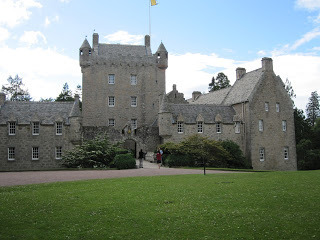 Cawdor Castle The chieftains did not ignore the Church rules entirely, butRome was a long way away so they generally followed the principle that it wasbetter to ask forgiveness than permission. Though a chieftain might seek anannulment, he was unlikely to wait the two or three years to get an answer fromRome before taking a new wife. The petitionfor annulment was often based on the marriage being in violation of the rulesof consanguinity, though everyone had been well aware of the issue at the time ofthe marriage.
Cawdor Castle The chieftains did not ignore the Church rules entirely, butRome was a long way away so they generally followed the principle that it wasbetter to ask forgiveness than permission. Though a chieftain might seek anannulment, he was unlikely to wait the two or three years to get an answer fromRome before taking a new wife. The petitionfor annulment was often based on the marriage being in violation of the rulesof consanguinity, though everyone had been well aware of the issue at the time ofthe marriage.
As might be expected, a clan chieftain's serial (andsometimes concurrent) marriages did not always lead to family harmony or goodrelations with other clans. The MacDonalds of Sleat, the clan of my fictionalheroes, had their share of such conflict.
Hugh (Uisdean), the first MacDonald of Sleat and thegrandfather of my fictional character Connor, was one of three sons thatAlexander, the third Lord of the Isles, had by different women. Despite beingadmonished by the pope himself for putting away his true wife and "adhering" toHugh's beautiful and highborn mother, Alexander refused to part with her. Hishalf-sons, however, got along well.
Hugh had six sons by six different women, all from prominentfamilies. Unfortunately, his sons did not get along as well as Hugh had withhis half-brothers. In fact, Hugh's first son hated his half-brothers so muchthat upon his death he turned the clan's lands over to the Crown to keep theothers from inheriting them. Though later chieftains held onto the lands, theirlack of legal title caused the clan problems for years. Two of Hugh's othersons were murdered by their half-brothers, and another was murdered by Hugh's grandsons.
This family strife plays an important role in all four booksin THE RETURN OF THE HIGHLANDERS. In THE SINNER, I also included as secondarycharacters two couples who were wed in order to make alliances between their respectiveclans—with wildly differing results.
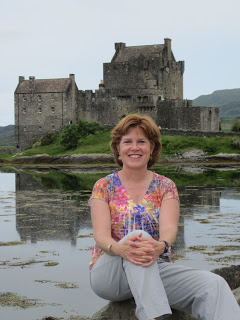 Margaret Mallory at Eilean DonanI drew on a well-known incident involving the Macleanchieftain, Lachlan Cattanach (Shaggy), and his wife Catherine, whose father andthen brother were chieftains of the powerful Campbell clan. I won't say herewhat happened, but when Shaggy was found murdered in bed on a visit to Edinburghsome years later, everyone assumed it was done by a Campbell in retribution.
Margaret Mallory at Eilean DonanI drew on a well-known incident involving the Macleanchieftain, Lachlan Cattanach (Shaggy), and his wife Catherine, whose father andthen brother were chieftains of the powerful Campbell clan. I won't say herewhat happened, but when Shaggy was found murdered in bed on a visit to Edinburghsome years later, everyone assumed it was done by a Campbell in retribution.
Catherine's brother John had better luck in marriage. Whenthe Thane of Cawdor died leaving his baby daughter Muriel as his sole heir,clan chieftains all over the Highlands hoped to arrange a match that wouldresult in one of their sons becoming the next Thane of Cawdor one day. WhenMuriel was still a toddler, the Campbell chieftain preempted the others byhaving his men snatch Muriel when she was outside the walls of Cawdor Castletaking in the fresh air with her nursemaid. Muriel was raised in the Campbellchieftain's household and married to John as soon as she reached twelve, theage of consent. By all reports, this marriage, which was made solely for thepurpose of gaining lands and wealth for the Campbells, was a very happy one.
Then as now, some marriages turnout well despite how they started.
* My primary source is "Marriage, Concubinage and Divorce inGaelic Scotland," by David Sellar, from Volume 51 of the Transactions of the Gaelic Society of Inverness. (Thanks to SharronGunn for referring me to the article.) I also found supporting information inclan histories from numerous sources.
~~~
I hope you'llenjoy the slide show I put together of photos I took of some of the castles& other settings that appear in THE SINNER. To see the show, click here ,then click on "show info" on the upper right for descriptions.
For Book GroupDiscussion Questions, blurbs, excerpts, and other information relating to mybooks, please visit my website: www.MargaretMallory.com.
I'd love torespond to your comments or questions! I'll give away a signed copy of THESINNER to one of the commenters. *~*~*~*
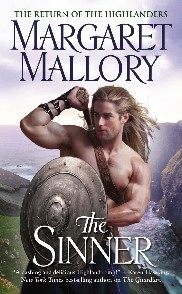 THE RETURN OF THE HIGHLANDERS: BOOK 2
THE RETURN OF THE HIGHLANDERS: BOOK 2
Four fearless warriors return to the Highlands to claim their lands and legacies. But all their trials on the battlefield can't prepare them for their greatest challenge yet: winning the hearts of four willful Scottish beauties.
IRRESISTIBLE DESIRE
Alex MacDonald is known for his skill as a warrior, his prowess with women, and his vow to never take a wife. But now his chieftain has asked him to make the ultimate sacrifice: wed Glynis MacNeil, a lass famed throughout the Highlands for her exquisite beauty—and defiant ways.
Familiar with heartbreak, Glynis refuses to fall for another handsome scoundrel. Yet when Alex's past sins force an unlikely union, Glynis gives in to temptation and becomes his wife. Will their newfound passion be strong enough to fight the enemy that threatens their home, their clan, and their very lives?

Marriage in the Highlands in the Early 1500's*Margaret Mallory
[image error] Dunscaith, home of the Chieftain of the MacDonalds of SleatThe most surprising thing I learned in my research for myTHE RETURN OF THE HIGHLANDERS series was about the marriage practices of Highlandersin the Western Isles, particularly the chieftains, at that time my books takeplace.
In the early 1500's, these Gaelic-speaking Highlanders maintainedtheir old Celtic customs alongside their Christian beliefs. Priests were notnecessary to make a marriage, which was fortunate since priests were few and farbetween in the Highlands at this time. In Celtic secular marriage, it wascommon for couples to enter a trial marriage. At the end of a year, eitherparty could leave the marriage. If the couple decided to stick with it, they couldhave their marriage blessed at the same time their first child was christenedwhen the priest made his rounds. Childrenborn of these trial marriages were considered legitimate, and men generallyclaimed children born outside of marriage as well. Divorce was permitted by either party onfairly loose grounds.
Chieftains, who were more than kings to their clans, disregardededicts from Rome as freely as they ignored edits from the Crown. For them, marriage was a means of making analliance with another clan—and they changed alliances all the time. Henry VIII had nothing on some of thesechieftains when it came to multiple wives, though a chieftain could simply "setaside" a wife, rather than look for an excuse to have her killed.
 Cawdor Castle The chieftains did not ignore the Church rules entirely, butRome was a long way away so they generally followed the principle that it wasbetter to ask forgiveness than permission. Though a chieftain might seek anannulment, he was unlikely to wait the two or three years to get an answer fromRome before taking a new wife. The petitionfor annulment was often based on the marriage being in violation of the rulesof consanguinity, though everyone had been well aware of the issue at the time ofthe marriage.
Cawdor Castle The chieftains did not ignore the Church rules entirely, butRome was a long way away so they generally followed the principle that it wasbetter to ask forgiveness than permission. Though a chieftain might seek anannulment, he was unlikely to wait the two or three years to get an answer fromRome before taking a new wife. The petitionfor annulment was often based on the marriage being in violation of the rulesof consanguinity, though everyone had been well aware of the issue at the time ofthe marriage. As might be expected, a clan chieftain's serial (andsometimes concurrent) marriages did not always lead to family harmony or goodrelations with other clans. The MacDonalds of Sleat, the clan of my fictionalheroes, had their share of such conflict.
Hugh (Uisdean), the first MacDonald of Sleat and thegrandfather of my fictional character Connor, was one of three sons thatAlexander, the third Lord of the Isles, had by different women. Despite beingadmonished by the pope himself for putting away his true wife and "adhering" toHugh's beautiful and highborn mother, Alexander refused to part with her. Hishalf-sons, however, got along well.
Hugh had six sons by six different women, all from prominentfamilies. Unfortunately, his sons did not get along as well as Hugh had withhis half-brothers. In fact, Hugh's first son hated his half-brothers so muchthat upon his death he turned the clan's lands over to the Crown to keep theothers from inheriting them. Though later chieftains held onto the lands, theirlack of legal title caused the clan problems for years. Two of Hugh's othersons were murdered by their half-brothers, and another was murdered by Hugh's grandsons.
This family strife plays an important role in all four booksin THE RETURN OF THE HIGHLANDERS. In THE SINNER, I also included as secondarycharacters two couples who were wed in order to make alliances between their respectiveclans—with wildly differing results.
 Margaret Mallory at Eilean DonanI drew on a well-known incident involving the Macleanchieftain, Lachlan Cattanach (Shaggy), and his wife Catherine, whose father andthen brother were chieftains of the powerful Campbell clan. I won't say herewhat happened, but when Shaggy was found murdered in bed on a visit to Edinburghsome years later, everyone assumed it was done by a Campbell in retribution.
Margaret Mallory at Eilean DonanI drew on a well-known incident involving the Macleanchieftain, Lachlan Cattanach (Shaggy), and his wife Catherine, whose father andthen brother were chieftains of the powerful Campbell clan. I won't say herewhat happened, but when Shaggy was found murdered in bed on a visit to Edinburghsome years later, everyone assumed it was done by a Campbell in retribution. Catherine's brother John had better luck in marriage. Whenthe Thane of Cawdor died leaving his baby daughter Muriel as his sole heir,clan chieftains all over the Highlands hoped to arrange a match that wouldresult in one of their sons becoming the next Thane of Cawdor one day. WhenMuriel was still a toddler, the Campbell chieftain preempted the others byhaving his men snatch Muriel when she was outside the walls of Cawdor Castletaking in the fresh air with her nursemaid. Muriel was raised in the Campbellchieftain's household and married to John as soon as she reached twelve, theage of consent. By all reports, this marriage, which was made solely for thepurpose of gaining lands and wealth for the Campbells, was a very happy one.
Then as now, some marriages turnout well despite how they started.
* My primary source is "Marriage, Concubinage and Divorce inGaelic Scotland," by David Sellar, from Volume 51 of the Transactions of the Gaelic Society of Inverness. (Thanks to SharronGunn for referring me to the article.) I also found supporting information inclan histories from numerous sources.
~~~
I hope you'llenjoy the slide show I put together of photos I took of some of the castles& other settings that appear in THE SINNER. To see the show, click here ,then click on "show info" on the upper right for descriptions.
For Book GroupDiscussion Questions, blurbs, excerpts, and other information relating to mybooks, please visit my website: www.MargaretMallory.com.
I'd love torespond to your comments or questions! I'll give away a signed copy of THESINNER to one of the commenters. *~*~*~*
 THE RETURN OF THE HIGHLANDERS: BOOK 2
THE RETURN OF THE HIGHLANDERS: BOOK 2Four fearless warriors return to the Highlands to claim their lands and legacies. But all their trials on the battlefield can't prepare them for their greatest challenge yet: winning the hearts of four willful Scottish beauties.
IRRESISTIBLE DESIRE
Alex MacDonald is known for his skill as a warrior, his prowess with women, and his vow to never take a wife. But now his chieftain has asked him to make the ultimate sacrifice: wed Glynis MacNeil, a lass famed throughout the Highlands for her exquisite beauty—and defiant ways.
Familiar with heartbreak, Glynis refuses to fall for another handsome scoundrel. Yet when Alex's past sins force an unlikely union, Glynis gives in to temptation and becomes his wife. Will their newfound passion be strong enough to fight the enemy that threatens their home, their clan, and their very lives?
Published on November 01, 2011 04:19
October 28, 2011
Guest Author Sarah Richmond Takes Your On a Tour of Placerville
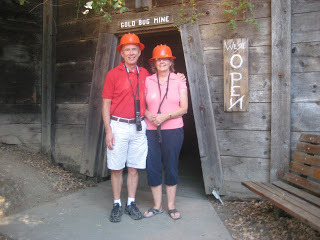
Author Sarah Richmond and her husband take a self-guided tour in a gold mine. More information canbe found at www. goldbugpark.orgI'd like to welcome to History Undressed my good friend and crit partner, Sarah Richmond! Sarah writes sweet historical romance, set in the West. Her book DULCIE CROWDER GETS HER MAN, comes out with Avalon in December of this year. Take it away Sarah!
Okay. You weren't expecting a blog on setting. Forhistorical writers especially, setting is most definitely one of yourcharacters. How better to undress a setting but with details?
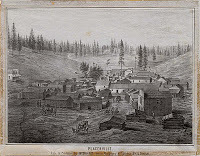
Placerville, CA, one of the communities thatsprung up because of the gold rush.While researching for those important details for "DulcieCrowder", I found myself in Placerville, CA in El Dorado County,where gold was discovered in 1848 at Sutter's Mill near Coloma. Placerville used to becalled Hangtown because of a white oak tree in the center of town where justicewas carried out. (The stump of the hanging tree remains-- taking pride of placein a bar on Main Street).
[image error]
A replica of a nineteenth century Mercantile can be found atthe County Museum. Notice the hand bill for MarkTwain. Candy jars. Their web site is www.co.el-dorado.ca.usThe Historical Society (524 Main Street) is housed in theFountain & Tallman Soda Works, yes, a soda factory. The Museum is one ofthe few buildings to survive the fire of 1854. The docents there areknowledgeable and eager to answer any questions. They will teach you how sodawater was made.
On display are a number of photographs of localpersonalities. I was surprised at howsmall the people were in the nineteenth century. The woman's shoes and dresseson display look like they would fit today's sixth grader.
[image error]
Placervillereconstructed after the 1856 fire. Notice the bell tower to call theirvolunteer fire department.The Placerville Historical Museumis another treasure trove of information. The county museum is next to the ElDorado Fairgrounds where I went to visit the gun show. I found an antiquedealer who showed me an old Sharps Rifle and how to fire it. The rifle has twotriggers: a set trigger and one to fire. My hero had to have one. He sends fora Sharps from back East and has to show off to the heroine how the new rifleworks.
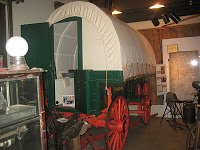 A wagon built by John Studebaker.
A wagon built by John Studebaker. He also madewheelbarrows.
The museum also houses steam engines. The Museum has a number of displays depicting scenes fromthe gold rush era including a General Store. The miners paid for theirmerchandise with gold dust. Sometimes the dust fell through the cracks in thefloorboards making the ground underneath the store a good place to mine forgold. John Studebaker, famous as a manufacturer of automobiles, became wealthymaking wagons and wheelbarrows during the gold rush.
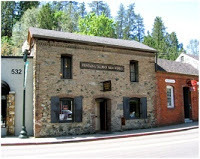
The website for the Placerville Historical Museum is http://homepage.mac.com/placerville/gold/Welcome.htmland islocated at 524 Main Street, Placerville.Gold Bug Parkwas another stop. There's a small museum and visitors can explore a gold mineon a tour or self-guided tour. The mine was wet and cold. Imagine being down inthe mine with a lantern and pick ax and hearing that bell being rung signalinga dynamite blast. How chilling to wonder if the timbers would hold the tons ofearth overhead and to fear the way out might be blocked by a cave in.
I made a quick trip to the nearby Joshua Handy Stamp Millwhere the sound of the ore crusher could be heard day and night. Can youimagine the noise? That was later, after 1860 when placer mining became less productive.Maybe the next book?
These are some of the tidbits I learned while in Placerville. I hope youenjoyed the trip. You can read more about Dulcie Crowder at SarahRichmond.com
Cheers,
Sarah Richmond
[image error] DULCIE CROWDER GETS HER MANAvalon BooksDecember, 2011Sarah Richmond.com
After her father's death, Dulcie Crowder leaves their El Dorado claim andtravels to Hangtown. Her aim is matrimony and she sets her hat for the handsomedeputy, Tom Walker. When Tom balks, she knows why. He wants a woman he can beproud to walk beside, so Dulcie tries hard to transform herself into a lady. Tom has vowed to bring law and order to the hardscrabblegold rush town and knows Hangtown is no place for a wife and family. As Dulcietries to turn his head and win his heart, he notices. So do the hoards of otherlonely men in their community. Dulcie finds out her father was hung for murder and Tom isthe one who put the noose around his neck. She has to dig deep for forgivenessand wonders if the citizens of Hangtown will ever accept her as one of them.The Vigilance Society is ready to run her and other strangers out of town.There's an election coming up and the head of the Society is standing forSheriff.
When Dulcie discovers corruption in the judiciary during thetrial of a friend, she naturally turns to Tom. The deputy looks for evidencebut Dulcie has other ideas on how to catch a varmint. As they both work forjustice, will she jeopardize her chances of getting her man?
Published on October 28, 2011 06:18
Historical Romance Review: My Wild Highlander by Vonda Sinclair
Boy was I excited to get the .pdf of MY WILD HIGHLANDER loaded up after having thorougly enjoyed the first book in Vonda Sincair's series, MY FIERCE HIGHLANDER. I am a series girl, through and through. I love to catch glimpes of characters from stories past, and I love to hear stories of characters introduced in other tales. That being said, author's often have a hard time topping the first in a series. Not so with Ms. Sinclair's second book. I truly enjoyed MY WILD HIGHLANDER, a highly sensual, action packed, tale of love and how people can change for the better.
 ABOUT THE BOOK:
ABOUT THE BOOK:
Lady Angelique Drummagan, a half-Scottish, half-French countess, has suffered much pain and betrayal in her past. She wants nothing to do with the sensual Scottish warrior that the king has ordered her to marry because the rogue could never be a faithful husband, but she has little choice in the matter. Dangerous, greedy enemies threaten her from all sides and she's in dire need of his protection.
Sir Lachlan MacGrath, known as Seducer of the Highlands, possesses a charming wickedness and canny wit which has earned him much popularity. After the king decrees that he wed the fiery hellion, Lachlan discovers there is one woman who can resist him—Angelique. Can he break through her icy façade and melt her heart, or will the dark secrets lurking in her past not only cost them their future together, but their very lives?
Available now in ebook.
MY REVIEW:
MY WILD HIGHLANDER opens with a great, scintillating, somewhat humorous scene--and the drama doesn't end there. Ms. Sinclair did a fantastic job keeping the reader hooked in the story.
Once again her attention to detail, historical flavor, and character development were on top! I fell in love with the roguish Lachlan--a Highlander after my own heart. He is funny, sensual, good in bed, loyal, but he's also troubled and dealing with a lot of internal conflict which I enjoyed watching him work through, and come out on top.
Angelique is also dealing with some wicked demons from her past who constantly come back to taunt and torment her. Through her relationship with a man she grows to trust and love (albeit it is a painful struggle!) she is able to sort through the hurts of her past, and becomes a better person for it.
There is a lot of action in this story. Battles, secrets, traitors, friendship, dark pasts, villains, and on top of that, highly sensual, playful, unique love scenes. Ms. Sinclair did a top notch job getting into her characters' heads and portraying them on paper for the reader to truly experience their tale.
Kudos to Ms. Sinclair for penning another great book!

 ABOUT THE BOOK:
ABOUT THE BOOK:Lady Angelique Drummagan, a half-Scottish, half-French countess, has suffered much pain and betrayal in her past. She wants nothing to do with the sensual Scottish warrior that the king has ordered her to marry because the rogue could never be a faithful husband, but she has little choice in the matter. Dangerous, greedy enemies threaten her from all sides and she's in dire need of his protection.
Sir Lachlan MacGrath, known as Seducer of the Highlands, possesses a charming wickedness and canny wit which has earned him much popularity. After the king decrees that he wed the fiery hellion, Lachlan discovers there is one woman who can resist him—Angelique. Can he break through her icy façade and melt her heart, or will the dark secrets lurking in her past not only cost them their future together, but their very lives?
Available now in ebook.
MY REVIEW:
MY WILD HIGHLANDER opens with a great, scintillating, somewhat humorous scene--and the drama doesn't end there. Ms. Sinclair did a fantastic job keeping the reader hooked in the story.
Once again her attention to detail, historical flavor, and character development were on top! I fell in love with the roguish Lachlan--a Highlander after my own heart. He is funny, sensual, good in bed, loyal, but he's also troubled and dealing with a lot of internal conflict which I enjoyed watching him work through, and come out on top.
Angelique is also dealing with some wicked demons from her past who constantly come back to taunt and torment her. Through her relationship with a man she grows to trust and love (albeit it is a painful struggle!) she is able to sort through the hurts of her past, and becomes a better person for it.
There is a lot of action in this story. Battles, secrets, traitors, friendship, dark pasts, villains, and on top of that, highly sensual, playful, unique love scenes. Ms. Sinclair did a top notch job getting into her characters' heads and portraying them on paper for the reader to truly experience their tale.
Kudos to Ms. Sinclair for penning another great book!
Published on October 28, 2011 05:37
October 26, 2011
Interview with Janet Mullany
 Today on History Undressed we have a special guest, Janet Mullany! Not only is Janet a fabulous author, but she has a wicked sense of humor. Leave a comment for a chance to be entered in Janet's giveaway--a copy of her new release,
JANE AUSTEN: BLOOD PERSUASIAN
!
Today on History Undressed we have a special guest, Janet Mullany! Not only is Janet a fabulous author, but she has a wicked sense of humor. Leave a comment for a chance to be entered in Janet's giveaway--a copy of her new release,
JANE AUSTEN: BLOOD PERSUASIAN
!Welcome back to History Undressed Janet! Can you tell readers more about your upcoming release, BLOOD PERSUASIAN?
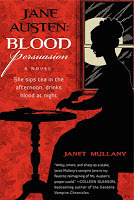 Hi Eliza, thanks for having me back! JABP is my second book about JaneAusten as a (temporary) vampire, the first being JANE AND THE DAMNED (HarperCollins2010). This one is set in 1810 in Chawton, the village where Austen did themajority of her writing, revising P&P,S&S, and Northanger Abbey,and writing Persuasion, Emma, and Mansfield Park. She believes her timeas one of the Damned, the sexy vampires of Georgian England, is over, but thennew neighbors move in, and they include her Creator William, with whom sheshares a troubled, deep bond (but not a romantic one) and her former Bearleaderand Consort, Luke, who is still holding a grudge. Their proximity threatens thereturn of her vampire characteristics, and she finds herself involved in avampire civil war and family members misbehaving with the Damned, which upsetsher writing schedule no end.
Hi Eliza, thanks for having me back! JABP is my second book about JaneAusten as a (temporary) vampire, the first being JANE AND THE DAMNED (HarperCollins2010). This one is set in 1810 in Chawton, the village where Austen did themajority of her writing, revising P&P,S&S, and Northanger Abbey,and writing Persuasion, Emma, and Mansfield Park. She believes her timeas one of the Damned, the sexy vampires of Georgian England, is over, but thennew neighbors move in, and they include her Creator William, with whom sheshares a troubled, deep bond (but not a romantic one) and her former Bearleaderand Consort, Luke, who is still holding a grudge. Their proximity threatens thereturn of her vampire characteristics, and she finds herself involved in avampire civil war and family members misbehaving with the Damned, which upsetsher writing schedule no end.Polite society was so...well, uptight! I bet you had a lot of fun playing on their delicate sensibilities. In what ways do the Damned trample upon etiquette and acceptable manners?
The way I structured the Damned was tohave them as a separate group within society—they're "out," in other words, althoughthey can conceal their identity. In this book they've lost the patronage of thePrince of Wales (who became the Prince Regent) and they're trying, ratherunsuccessfully, to adapt to country life. Their main interest even in reducedcircumstances remains unchanged--inviting people to dine, which is their termfor feeding. The Damned themselves are pretty uptight in their own way,obsessed with manners and protocol as a mirror image of society, and I had alot of fun coming up with terms that seemed historically correct—like "dining"for feeding, "en sanglant" for experiencing exposed fangs. Of course for Janethe major conflict is that the Damned are, literally, damned—they're immortalbut not indestructible and are destined for hell. What's a vicar's daughter todo?
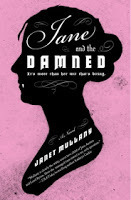 What is she to do indeed? So tell us, what sort of research did you do for this book? Does you use of the word "persuasion" in the title have anything to do with Jane Austen's book Persuasion? If so, how?
What is she to do indeed? So tell us, what sort of research did you do for this book? Does you use of the word "persuasion" in the title have anything to do with Jane Austen's book Persuasion? If so, how?
I did a lot of research on reading Austen's letters, visiting Chawtonlast year, and also Chawton Great House, which was owned by Jane's brotherEdward, the adopted heir of a local landowning family. He was the one whoprovided Jane, her sister and her mother their home in the village. In the bookChawton Great House is rented by the Damned. I think the title was chosenbecause it's about a rekindling of a love affair, but mine has a lot morebiting in it.
What is your favorite quote from the book?
Here's Luke trying to seduce Jane. She resists because every time they havephysical contact it brings her closer to turning back into a vampire(metamorphosis):
"Ah,you're so close," he murmured. "Your skin is like satin, Jane. I'd clothe youin satin, if I clothed you at all. I'd break strands of pearls to see them rollon your skin and warm. You smell like summer fruit, my love, ripe and sweet,and your heart beats so fast. Let me, Jane. I'll bite here, just a little." Hisbreath scorched the skin of her arm. "You remember how it felt? That shock, andyou can't decide whether it's pain or a wonderful violation, and then the tugand the shiver as you lose yourself." His lips trailed down her arm, followingthe slide of the kid glove, pausing again at the wrist. "Or here? Yes, herewhere your pulse is strongest, and all anyone will see is that I kiss yourwrist, but you and I, we both know it's more. A close observer might wonder atthe brightness of your eyes, and the way your lips part …"
[image error] Are there plans for you to write more Jane Austen books?
No, this is the second and last one. What I intended to do was work someof the known facts about Austen's life into the books, so the first one was setin 1797 when the family visited Bath, because I wanted to set the book in thatcity. This one is set around a specific period in Jane's life, when her nieceAnna visited the household for a few weeks in the spring of 1810. I didn't wantJane to mysteriously fake her death in 1817 and become some sort of vampiresocialite. One of the rules I set up in the first book was that she couldn'twrite as a vamp and in this book, because the metamorphosis is different, shecan write but it's a very different sort of book, which explains Mansfield Park (originally all aboutvamps until her brothers made her change it!).
I have another Austen-related release this month, as a contributor to ananthology, JANE AUSTEN MADE ME DO IT, but it's nothing to do with my booksabout Austen. I went out on a limb and wrote a story set in 1964 about theBeatles (Jane Austen, Yeah, Yeah, Yeah!).
Do you have a question for readers?
Do you like books that have real historical characters in them? Tell uswhich books you've enjoyed.
*~*~*~*Janet Mullany was raised in England by half of an amateur string quartet and now lives near Washington, DC. Persecuted from an early age for reading too long in the bathroom, she still loves books and is an avid and eclectic reader. She has worked as an archaeologist, classical music radio announcer, arts administrator, and for a small press. Visit her at www.janetmullany.com
Published on October 26, 2011 03:21
October 20, 2011
Keeping it in the (Ptolemaic) Family: When Incest is Best by Stephanie Dray
Welcome back to History Undressed a fabulous author who I admire--Stephanie Dray. If you haven't already read her previous article, Bad Girls of the Ancient World, you will want to! Today she's hear to talk with us about a very controversial topic, that also happens to take center stage in her new novel, Song of the Nile, which I reviewed earlier this week.
Without further ado... I give you Ms. Dray!
 Keeping it in the (Ptolemaic) Family: When Incest is BestbyStephanie Dray
Keeping it in the (Ptolemaic) Family: When Incest is BestbyStephanie Dray
There are a whole slew of fantastically good reasons why incest is illegal and taboo, including the lasting psychological damage it does, and the dysfunctional family dynamics it creates. That said, there's a good chance that the Ptolemaic Dynasty would have been filled with fratricidal thugs and harpies even if they hadn't made it a practice to marry their siblings.
I say this because just about every relationship in the ancient world was founded upon some manner of abusive power. While we romanticize the relationship between Cleopatra VII and Julius Caesar, and especially the relationship between Cleopatra and Mark Antony, both of these love affairs were based on mutual political interest--in Cleopatra's case, a desire to stay alive. While many accused her of seduction, the fact remains when she rolled herself out at the feet of the Roman general, she was more than thirty years his junior, and utterly at his mercy.
Today, we would rightly question the ethics of these love affairs, but given the way women were treated in the ancient world--and even until recently--her relationships with these men seems positively enlightened. Especially when you contrast them with the sexual relationships she was supposed to have as the Queen of Egypt.
To wit, she was not only expected to marry her brother, but to have children by him.
So, how did this come to pass? The Ptolemies considered themselves to be the successors to Alexander the Great--that Macedonian King who conquered the known world. Ptolemy was his general, and some said his half-brother. After Alexander the Great died and his empire was broken up, Egypt fell into the hands of Ptolemy and a dynasty was born.
His daughter, Arsinoe II, would start the tradition of incest. Married off to an old King of Thrace when she was still a teenager, she was the ultimate survivor. Her life was frequently in danger and she made many narrow escapes, including one from the Seleucid Army marching on her kingdom. At some point, Arsinoe seems to have decided that if she wanted to be safe, she couldn't trust anyone outside her immediate family. So, she returned to Egypt and married her full brother, Ptolemy II.
Now, the Greeks didn't have a tradition of incest in their ruling families...but the pharaohs of Egypt did. By marrying her brother, Arsinoe was able to help create a link between the new Ptolemaic dynasty and the very old traditions of the native Egyptians. It served her extremely well as she became the first female pharaoh of the Ptolemaic dynasty, ruling not just as the wife of the king, but as a king in her own right.
After that, the tradition took hold and not simply because all the cool kids were doing it. The Ptolemies discovered that incest served some important political purposes. For one, it kept out the riff-raff. Incestuous marriages virtually ensured that the Macedonian ruling family would never have to dilute its blood with native Egyptians, for whom they seemed to hold some disdain. Moreover, it put the kibosh on social mobility. No ambitious little Macedonian or Egyptian boys would grow up with the dream that they, too, could be pharaoh as long as they worked hard, sucked up, and poisoned the right people.
The best an ambitious man could hope for was to make his daughter a concubine to the king, which might, if the queen was infertile, allow him to one day become grandfather and vizier to the next king. Consequently, a tradition of Ptolemaic incest kept the threat of being poisoned by outsiders to a minimum.
Another advantage to keeping it in the family was that foreign powers couldn't get a foothold in Egypt. The usual way by which empires encroached upon one another was by marriage. If I'm the king of the nearby Seleucid empire, for example, it might be a good idea to marry my daughter off to the King of Egypt. Then, when the pharaoh is old and feeble, I could claim the throne in the name of my grandson with my own army to back me. But if Ptolemaic kings only marry their sisters or daughters or nieces, I don't have a prayer.
So, the potential for foreign invasion and manipulation was reduced by incest. But what of internal conflicts? Well, when you marry your own sisters you can maintain control over your nephews--all of whom would have a claim to your throne. It's an easy solution to turn them into sons!
You might assume that the Ptolemaic gene pool would produce a lot of inbred drooling abominations, but aside from a tendency towards weight-gain and buggy eyes, the Ptolemies don't appear to have suffered any genetic abnormalities. Unless you count the unflinching resolve to murder your siblings as a matter of nature rather than nurture.
Apparently, familiarity breeds contempt and the Ptolemies became a fratricidal lot. The family infighting was ruthless and deadly; there was no defense against those family dynamics.
So was it worth it?
Well, the evidence tells us that it was. The Ptolemies ruled Egypt for almost three hundred years. And if the Battle of Actium had gone the other way, Egyptian culture would have dominated western civilization.
Bio
Stephanie graduated from Smith, a small women's college in Massachusetts where–to the consternation of her devoted professors–she was unable to master Latin. However, her focus on Middle Eastern Studies gave her a deeper understanding of the consequences of Egypt's ancient clash with Rome, both in terms of the still-extant tensions between East and West as well as the worldwide decline of female-oriented religion.Before she wrote novels, Stephanie was a lawyer, a game designer, and a teacher. Now she uses the transformative power of magic realism to illuminate the stories of women in history and inspire the young women of today. She remains fascinated by all things Roman or Egyptian and has–to the consternation of her devoted husband–collected a house full of cats and ancient artifacts. BlurbSorceress. Seductress. Schemer. Cleopatra's daughter has become the emperor's most unlikely apprentice and the one woman who can destroy his empire…Having survived her perilous childhood as a royal captive of Rome, Selene pledged her loyalty to Augustus and swore she would become his very own Cleopatra. Now the young queen faces an uncertain destiny in a foreign land.Forced to marry a man of the emperor's choosing, Selene will not allow her new husband to rule in her name. She quickly establishes herself as a capable leader in her own right and as a religious icon. Beginning the hard work of building a new nation, she wins the love of her new subjects and makes herself vital to Rome by bringing forth bountiful harvests.But it's the magic of Isis flowing through her veins that makes her indispensable to the emperor. Against a backdrop of imperial politics and religious persecution, Cleopatra's daughter beguiles her way to the very precipice of power. She has never forgotten her birthright, but will the price of her mother's throne be more than she's willing to pay?Berkley Trade October 2011 (Trade Paperback)
BlurbSorceress. Seductress. Schemer. Cleopatra's daughter has become the emperor's most unlikely apprentice and the one woman who can destroy his empire…Having survived her perilous childhood as a royal captive of Rome, Selene pledged her loyalty to Augustus and swore she would become his very own Cleopatra. Now the young queen faces an uncertain destiny in a foreign land.Forced to marry a man of the emperor's choosing, Selene will not allow her new husband to rule in her name. She quickly establishes herself as a capable leader in her own right and as a religious icon. Beginning the hard work of building a new nation, she wins the love of her new subjects and makes herself vital to Rome by bringing forth bountiful harvests.But it's the magic of Isis flowing through her veins that makes her indispensable to the emperor. Against a backdrop of imperial politics and religious persecution, Cleopatra's daughter beguiles her way to the very precipice of power. She has never forgotten her birthright, but will the price of her mother's throne be more than she's willing to pay?Berkley Trade October 2011 (Trade Paperback)
# ISBN-10: 0425243044
# ISBN-13: 9780425243046Purchase InfoAmazonB&NIndieBoundBordersConstellation BooksPowell's
Enter Stephanie Dray's Contest: Review My Book and Win a Nook!
Write and post an honest review of any of my books on either Amazon.com, B&N, or Goodreads between now and December 1st 2011, and you will be eligible to win your choice of either a 1st generation Nook e-reader or a $75 gift certificate to B&N or Amazon.com, just in time for the holiday season.
To win:
1. Write a text review of one of my books for either Amazon.com, BarnesandNoble.com, or Goodreads.com
2. Post the link to your review(s) at: http://simplifyurl.com/ung
3. That's it.
A winner will be chosen at random, not based on the content of the review, so please be honest and thoughtful.
The Disclaimers:
Only reviews posted between September 15 and December 1, 2011 are eligible. You can review more than one book and on more than one site for extra entries in the contest–just be sure to post the link to your review(s) at simplifyurl.com/ung.
On December 2, 2011, one winner will be chosen. This contest will be held in tandem on my other website, StephanieDraven.com. You can enter the contest on either website. No purchase necessary. (Libraries are wonderful!) Any review that violates the policies of the sites listed above will be disqualified. Do not spam these sites with inappropriate comments only meant to win this contest or you will be reported for abuse. Contest is void where prohibited.

Without further ado... I give you Ms. Dray!
 Keeping it in the (Ptolemaic) Family: When Incest is BestbyStephanie Dray
Keeping it in the (Ptolemaic) Family: When Incest is BestbyStephanie DrayThere are a whole slew of fantastically good reasons why incest is illegal and taboo, including the lasting psychological damage it does, and the dysfunctional family dynamics it creates. That said, there's a good chance that the Ptolemaic Dynasty would have been filled with fratricidal thugs and harpies even if they hadn't made it a practice to marry their siblings.
I say this because just about every relationship in the ancient world was founded upon some manner of abusive power. While we romanticize the relationship between Cleopatra VII and Julius Caesar, and especially the relationship between Cleopatra and Mark Antony, both of these love affairs were based on mutual political interest--in Cleopatra's case, a desire to stay alive. While many accused her of seduction, the fact remains when she rolled herself out at the feet of the Roman general, she was more than thirty years his junior, and utterly at his mercy.
Today, we would rightly question the ethics of these love affairs, but given the way women were treated in the ancient world--and even until recently--her relationships with these men seems positively enlightened. Especially when you contrast them with the sexual relationships she was supposed to have as the Queen of Egypt.
To wit, she was not only expected to marry her brother, but to have children by him.
So, how did this come to pass? The Ptolemies considered themselves to be the successors to Alexander the Great--that Macedonian King who conquered the known world. Ptolemy was his general, and some said his half-brother. After Alexander the Great died and his empire was broken up, Egypt fell into the hands of Ptolemy and a dynasty was born.
His daughter, Arsinoe II, would start the tradition of incest. Married off to an old King of Thrace when she was still a teenager, she was the ultimate survivor. Her life was frequently in danger and she made many narrow escapes, including one from the Seleucid Army marching on her kingdom. At some point, Arsinoe seems to have decided that if she wanted to be safe, she couldn't trust anyone outside her immediate family. So, she returned to Egypt and married her full brother, Ptolemy II.
Now, the Greeks didn't have a tradition of incest in their ruling families...but the pharaohs of Egypt did. By marrying her brother, Arsinoe was able to help create a link between the new Ptolemaic dynasty and the very old traditions of the native Egyptians. It served her extremely well as she became the first female pharaoh of the Ptolemaic dynasty, ruling not just as the wife of the king, but as a king in her own right.
After that, the tradition took hold and not simply because all the cool kids were doing it. The Ptolemies discovered that incest served some important political purposes. For one, it kept out the riff-raff. Incestuous marriages virtually ensured that the Macedonian ruling family would never have to dilute its blood with native Egyptians, for whom they seemed to hold some disdain. Moreover, it put the kibosh on social mobility. No ambitious little Macedonian or Egyptian boys would grow up with the dream that they, too, could be pharaoh as long as they worked hard, sucked up, and poisoned the right people.
The best an ambitious man could hope for was to make his daughter a concubine to the king, which might, if the queen was infertile, allow him to one day become grandfather and vizier to the next king. Consequently, a tradition of Ptolemaic incest kept the threat of being poisoned by outsiders to a minimum.
Another advantage to keeping it in the family was that foreign powers couldn't get a foothold in Egypt. The usual way by which empires encroached upon one another was by marriage. If I'm the king of the nearby Seleucid empire, for example, it might be a good idea to marry my daughter off to the King of Egypt. Then, when the pharaoh is old and feeble, I could claim the throne in the name of my grandson with my own army to back me. But if Ptolemaic kings only marry their sisters or daughters or nieces, I don't have a prayer.
So, the potential for foreign invasion and manipulation was reduced by incest. But what of internal conflicts? Well, when you marry your own sisters you can maintain control over your nephews--all of whom would have a claim to your throne. It's an easy solution to turn them into sons!
You might assume that the Ptolemaic gene pool would produce a lot of inbred drooling abominations, but aside from a tendency towards weight-gain and buggy eyes, the Ptolemies don't appear to have suffered any genetic abnormalities. Unless you count the unflinching resolve to murder your siblings as a matter of nature rather than nurture.
Apparently, familiarity breeds contempt and the Ptolemies became a fratricidal lot. The family infighting was ruthless and deadly; there was no defense against those family dynamics.
So was it worth it?
Well, the evidence tells us that it was. The Ptolemies ruled Egypt for almost three hundred years. And if the Battle of Actium had gone the other way, Egyptian culture would have dominated western civilization.
Bio
Stephanie graduated from Smith, a small women's college in Massachusetts where–to the consternation of her devoted professors–she was unable to master Latin. However, her focus on Middle Eastern Studies gave her a deeper understanding of the consequences of Egypt's ancient clash with Rome, both in terms of the still-extant tensions between East and West as well as the worldwide decline of female-oriented religion.Before she wrote novels, Stephanie was a lawyer, a game designer, and a teacher. Now she uses the transformative power of magic realism to illuminate the stories of women in history and inspire the young women of today. She remains fascinated by all things Roman or Egyptian and has–to the consternation of her devoted husband–collected a house full of cats and ancient artifacts.
 BlurbSorceress. Seductress. Schemer. Cleopatra's daughter has become the emperor's most unlikely apprentice and the one woman who can destroy his empire…Having survived her perilous childhood as a royal captive of Rome, Selene pledged her loyalty to Augustus and swore she would become his very own Cleopatra. Now the young queen faces an uncertain destiny in a foreign land.Forced to marry a man of the emperor's choosing, Selene will not allow her new husband to rule in her name. She quickly establishes herself as a capable leader in her own right and as a religious icon. Beginning the hard work of building a new nation, she wins the love of her new subjects and makes herself vital to Rome by bringing forth bountiful harvests.But it's the magic of Isis flowing through her veins that makes her indispensable to the emperor. Against a backdrop of imperial politics and religious persecution, Cleopatra's daughter beguiles her way to the very precipice of power. She has never forgotten her birthright, but will the price of her mother's throne be more than she's willing to pay?Berkley Trade October 2011 (Trade Paperback)
BlurbSorceress. Seductress. Schemer. Cleopatra's daughter has become the emperor's most unlikely apprentice and the one woman who can destroy his empire…Having survived her perilous childhood as a royal captive of Rome, Selene pledged her loyalty to Augustus and swore she would become his very own Cleopatra. Now the young queen faces an uncertain destiny in a foreign land.Forced to marry a man of the emperor's choosing, Selene will not allow her new husband to rule in her name. She quickly establishes herself as a capable leader in her own right and as a religious icon. Beginning the hard work of building a new nation, she wins the love of her new subjects and makes herself vital to Rome by bringing forth bountiful harvests.But it's the magic of Isis flowing through her veins that makes her indispensable to the emperor. Against a backdrop of imperial politics and religious persecution, Cleopatra's daughter beguiles her way to the very precipice of power. She has never forgotten her birthright, but will the price of her mother's throne be more than she's willing to pay?Berkley Trade October 2011 (Trade Paperback)# ISBN-10: 0425243044
# ISBN-13: 9780425243046Purchase InfoAmazonB&NIndieBoundBordersConstellation BooksPowell's
Enter Stephanie Dray's Contest: Review My Book and Win a Nook!
Write and post an honest review of any of my books on either Amazon.com, B&N, or Goodreads between now and December 1st 2011, and you will be eligible to win your choice of either a 1st generation Nook e-reader or a $75 gift certificate to B&N or Amazon.com, just in time for the holiday season.
To win:
1. Write a text review of one of my books for either Amazon.com, BarnesandNoble.com, or Goodreads.com
2. Post the link to your review(s) at: http://simplifyurl.com/ung
3. That's it.
A winner will be chosen at random, not based on the content of the review, so please be honest and thoughtful.
The Disclaimers:
Only reviews posted between September 15 and December 1, 2011 are eligible. You can review more than one book and on more than one site for extra entries in the contest–just be sure to post the link to your review(s) at simplifyurl.com/ung.
On December 2, 2011, one winner will be chosen. This contest will be held in tandem on my other website, StephanieDraven.com. You can enter the contest on either website. No purchase necessary. (Libraries are wonderful!) Any review that violates the policies of the sites listed above will be disqualified. Do not spam these sites with inappropriate comments only meant to win this contest or you will be reported for abuse. Contest is void where prohibited.
Published on October 20, 2011 03:00
October 19, 2011
Seven Steps to Folding Your Own Condom by Linda Lee Graham
Today on History Undressed, I am very excited to introduce to you our guest author, Linda Lee Graham. She's written us a truly entertaining, fascinating historical article!! Take notes! Also don't forget to leave a comment for your chance to win an ebook copy of Linda's book, Voices Beckon. Enjoy!
[image error] Seven Steps to Folding Your Own Condomby Linda Lee Graham
Known as redingotes d'Anglaise(English raincoats) by the French, and baudruches(French letters), armour, sheaths, and machines by the English, condoms were abooming trade in eighteenth-century London. No matter the dire warnings fromthe Church, condemning the condom as immoral, and no matter the occasional prominentphysician who blasted it as useless, an ever-growing demand created thepotential for profit. Whenever that's the case, commerce finds a way to thrive.
Although its value as a contraceptive was known, evidence suggests itsprimary use was as a preventative. The threat of contracting "the great pox"was a very real concern in the 1700s. Atthe time, the term was used interchangeably to denote both gonorrhea (the clap)and syphilis, and the adjective "great," though not always present, distinguishedit from chickenpox and smallpox.
There was no effective cure for the pox, so the promise of preventionwas enticing. Payment could be high for that one quick indiscretion while outcarousing with one's mates—and if a lad had a friend, a sailor for Pete'ssake, who'd vowed he'd been usingcondoms for years with no sign of the dreaded pox—why wouldn't he be tempted toconsider the condom as well?
London entrepreneurs, not a few of them women, sold their wares intaverns, pubs, barbershops, and apothecaries, as well as hawked them streetsideand in open-air markets. Startup and operating costs were negligible. Animalintestines were inexpensive and easily obtained from the local butcher, sulfurand lye from the neighborhood apothecary, and silk ribbon from the localhaberdasher. The steps were simple:
Soak theintestines in water for several hours.Soften the mess bysoaking it in a weak lye solution for a day or two, changing the solution everytwelve hours.Scrape the mucousmembrane off the intestinal material.Soften theremaining matter over the vapor of 'burning brimstone' (steam it over hot sulfur).Wash what's leftwith lye soap and water.Cut intooblong-shaped pieces and fold up into a sack (about seven inches should do,maybe eight).Punch tiny holesaround the top edges and thread the ribbon (pink was especially popular) throughthose holes.
Voila! Onesize fits all.
[image error]
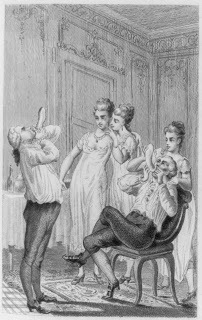
Casanova's Party TrickFor the truly ambitious, the moist gut instep six might be molded over an oiled glass cast that has been blown into theappropriate shape.
It's best not to try any of this at home. The fumes from the sulfur andlye can cause debilitating side effects and the effort might result in a condomriddled with holes. (Hence Casanova's Party Trick in image at right).
Visit the local drugstore instead.
A linen condom was easy to produce as well, provided one was proficientwith a needle. But the trade found the gut variety sold better, as the seam onthe linen condom proved uncomfortable to customers.
These little devices were expensive, and it was not uncommon for a manto save and reuse his armour. Buying, washing, and reselling used condomsevolved into a lucrative side occupation for those with ready access to abrothel.
Now, why this surge of capitalism didn't catch on in eighteenth-centuryPhiladelphia, I'm not sure. It certainly wasn't for lack of need. Immigrantsfrom all over the world flowed into the city through its harbor, making Philadelphiathe most ethnically and socially diverse city in the new United States, as wellas the city with the closest ties to Europe. Venereal disease was epidemicduring the last two decades of the 1700s, and casual sex, children borneoutside of wedlock, adultery, and prostitution were commonplace.
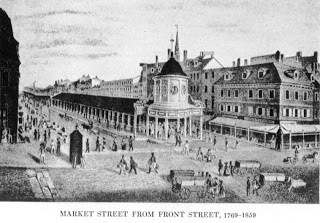 Nevertheless, it was one industry in which it appears our Americanforefathers lagged behind. It may be that individuals made do with their ownresources, or that the supply of black market condoms smuggled in by thecarrying trade was sufficient to fill the demand. But for whatever reason,evidence suggests condoms were not sold openly on Philadelphia's Market Street.
Nevertheless, it was one industry in which it appears our Americanforefathers lagged behind. It may be that individuals made do with their ownresources, or that the supply of black market condoms smuggled in by thecarrying trade was sufficient to fill the demand. But for whatever reason,evidence suggests condoms were not sold openly on Philadelphia's Market Street.
That began to change in the mid 1790s. Moreau de St. Méry, anex-patriot from France, visited Philadelphia in 1793 and decided to stay. Heopened a bookstore on Front and Walnutin 1794 and stocked it with condoms as well as books, thinking to provide forthe French colonials. He soon found the small items to be in great demand bythe Americans.
St. Méry credits himself that "the use of this medium on the vastAmerican continent dates from this time." And though happy to supply a need andmake a profit, he did deride the American customers' surreptitious purchase anduse. By the time he closed up shop in the late 1790s, Philadelphians could maketheir discreet purchases in any number of establishments.
The merit of condoms was subject for discussion in one of the scenes ofVoices Beckon, and not, heavenforbid, out of any desire to be "politically correct" on my part. I merely thoughtprotection would have been on the mind of any randy young lad with a mind tohis future.
Collier, Aine, The Humble Little Condom, A History,(Amherst, New York 2007)
Lyons, Clare, Sex Among the Rabble, An Intimate History ofGender & Power in the Age of Revolution, Philadelphia, 1730-1830(University of North Carolina Press, NC 2006)
St. Méry , Moreau de, Moreaude St. Méry's American Journey (1793-1798), translated and edited byKenneth Roberts and Anne Roberts, (Garden City, NY 1947)
Image of MarketStreet: Mather, Horace, Early Philadelphia: Its People, Life &Progress, (Philadelphia, PA 1917)
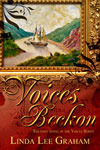 About the book:The year is 1783 and passengers are swarming the bustling Bristolquay, anxiously awaiting the call to board.
About the book:The year is 1783 and passengers are swarming the bustling Bristolquay, anxiously awaiting the call to board.
David Graham, a Scot indentured for the next six years to aPhiladelphia printer, waits among them, as does Elisabeth Hale, a youngEnglishwoman making the passage with her father, and Liam Brock, an orphanedScot with a dubious past.
Thrown together despite differences of class and religion, thesethree teens forge an unwavering bond of friendship, love, and loyalty—until Elisabethis forced to make a choice that threatens to shatter their world.
Voices Beckonspans seven years in the lives of David, Elisabeth, and Liam. Rich inhistorical detail, this sweeping romance chronicles their coming of age againstthe vivid backdrop of the developing United States of America.
Voices Beckonis available on Amazonand BarnesandNoble.I'd love for readers to stop by my website and follow me on Twitter.
[image error] Seven Steps to Folding Your Own Condomby Linda Lee Graham
Known as redingotes d'Anglaise(English raincoats) by the French, and baudruches(French letters), armour, sheaths, and machines by the English, condoms were abooming trade in eighteenth-century London. No matter the dire warnings fromthe Church, condemning the condom as immoral, and no matter the occasional prominentphysician who blasted it as useless, an ever-growing demand created thepotential for profit. Whenever that's the case, commerce finds a way to thrive.
Although its value as a contraceptive was known, evidence suggests itsprimary use was as a preventative. The threat of contracting "the great pox"was a very real concern in the 1700s. Atthe time, the term was used interchangeably to denote both gonorrhea (the clap)and syphilis, and the adjective "great," though not always present, distinguishedit from chickenpox and smallpox.
There was no effective cure for the pox, so the promise of preventionwas enticing. Payment could be high for that one quick indiscretion while outcarousing with one's mates—and if a lad had a friend, a sailor for Pete'ssake, who'd vowed he'd been usingcondoms for years with no sign of the dreaded pox—why wouldn't he be tempted toconsider the condom as well?
London entrepreneurs, not a few of them women, sold their wares intaverns, pubs, barbershops, and apothecaries, as well as hawked them streetsideand in open-air markets. Startup and operating costs were negligible. Animalintestines were inexpensive and easily obtained from the local butcher, sulfurand lye from the neighborhood apothecary, and silk ribbon from the localhaberdasher. The steps were simple:
Soak theintestines in water for several hours.Soften the mess bysoaking it in a weak lye solution for a day or two, changing the solution everytwelve hours.Scrape the mucousmembrane off the intestinal material.Soften theremaining matter over the vapor of 'burning brimstone' (steam it over hot sulfur).Wash what's leftwith lye soap and water.Cut intooblong-shaped pieces and fold up into a sack (about seven inches should do,maybe eight).Punch tiny holesaround the top edges and thread the ribbon (pink was especially popular) throughthose holes.
Voila! Onesize fits all.
[image error]

Casanova's Party TrickFor the truly ambitious, the moist gut instep six might be molded over an oiled glass cast that has been blown into theappropriate shape.
It's best not to try any of this at home. The fumes from the sulfur andlye can cause debilitating side effects and the effort might result in a condomriddled with holes. (Hence Casanova's Party Trick in image at right).
Visit the local drugstore instead.
A linen condom was easy to produce as well, provided one was proficientwith a needle. But the trade found the gut variety sold better, as the seam onthe linen condom proved uncomfortable to customers.
These little devices were expensive, and it was not uncommon for a manto save and reuse his armour. Buying, washing, and reselling used condomsevolved into a lucrative side occupation for those with ready access to abrothel.
Now, why this surge of capitalism didn't catch on in eighteenth-centuryPhiladelphia, I'm not sure. It certainly wasn't for lack of need. Immigrantsfrom all over the world flowed into the city through its harbor, making Philadelphiathe most ethnically and socially diverse city in the new United States, as wellas the city with the closest ties to Europe. Venereal disease was epidemicduring the last two decades of the 1700s, and casual sex, children borneoutside of wedlock, adultery, and prostitution were commonplace.
 Nevertheless, it was one industry in which it appears our Americanforefathers lagged behind. It may be that individuals made do with their ownresources, or that the supply of black market condoms smuggled in by thecarrying trade was sufficient to fill the demand. But for whatever reason,evidence suggests condoms were not sold openly on Philadelphia's Market Street.
Nevertheless, it was one industry in which it appears our Americanforefathers lagged behind. It may be that individuals made do with their ownresources, or that the supply of black market condoms smuggled in by thecarrying trade was sufficient to fill the demand. But for whatever reason,evidence suggests condoms were not sold openly on Philadelphia's Market Street.That began to change in the mid 1790s. Moreau de St. Méry, anex-patriot from France, visited Philadelphia in 1793 and decided to stay. Heopened a bookstore on Front and Walnutin 1794 and stocked it with condoms as well as books, thinking to provide forthe French colonials. He soon found the small items to be in great demand bythe Americans.
St. Méry credits himself that "the use of this medium on the vastAmerican continent dates from this time." And though happy to supply a need andmake a profit, he did deride the American customers' surreptitious purchase anduse. By the time he closed up shop in the late 1790s, Philadelphians could maketheir discreet purchases in any number of establishments.
The merit of condoms was subject for discussion in one of the scenes ofVoices Beckon, and not, heavenforbid, out of any desire to be "politically correct" on my part. I merely thoughtprotection would have been on the mind of any randy young lad with a mind tohis future.
Collier, Aine, The Humble Little Condom, A History,(Amherst, New York 2007)
Lyons, Clare, Sex Among the Rabble, An Intimate History ofGender & Power in the Age of Revolution, Philadelphia, 1730-1830(University of North Carolina Press, NC 2006)
St. Méry , Moreau de, Moreaude St. Méry's American Journey (1793-1798), translated and edited byKenneth Roberts and Anne Roberts, (Garden City, NY 1947)
Image of MarketStreet: Mather, Horace, Early Philadelphia: Its People, Life &Progress, (Philadelphia, PA 1917)
 About the book:The year is 1783 and passengers are swarming the bustling Bristolquay, anxiously awaiting the call to board.
About the book:The year is 1783 and passengers are swarming the bustling Bristolquay, anxiously awaiting the call to board.David Graham, a Scot indentured for the next six years to aPhiladelphia printer, waits among them, as does Elisabeth Hale, a youngEnglishwoman making the passage with her father, and Liam Brock, an orphanedScot with a dubious past.
Thrown together despite differences of class and religion, thesethree teens forge an unwavering bond of friendship, love, and loyalty—until Elisabethis forced to make a choice that threatens to shatter their world.
Voices Beckonspans seven years in the lives of David, Elisabeth, and Liam. Rich inhistorical detail, this sweeping romance chronicles their coming of age againstthe vivid backdrop of the developing United States of America.
Voices Beckonis available on Amazonand BarnesandNoble.I'd love for readers to stop by my website and follow me on Twitter.
Published on October 19, 2011 03:00



